Identification of Wind Load Exerted on the Jacket Wind Turbines from Optimally Placed Strain Gauges Using C-Optimal Design and Mathematical Model Reduction
Abstract
1. Introduction
2. Theory of Wind Load Identification for Offshore Wind Turbines
2.1. Frequency-Domain Dynamic Load Identification Theory
2.2. Ill Posedness of Systems of Linear Equations
2.3. Methods for Linear Systems
- (1)
- Moore–Penrose pseudo-inverse method;
- (2)
- TRM + L-curve: solving a system of linear equations using the TRM, where the regularisation parameter is derived by the L-curve criterion;
- (3)
- TRM + GCV: solving a system of linear equations using the TRM, where the regularisation parameter is derived using the GCV criterion;
- (4)
- TSVD + L-curve: solving a system of linear equations using the TSVD method, where the regularisation parameter is derived using the L-curve criterion;
- (5)
- TSVD + GCV: solving a system of linear equations using the TSVD method, where the regularisation parameter is derived using the GCV criterion.
3. Mathematical Model for Dynamic Load Identification in the Frequency Domain
3.1. Determination of Sensor Orientation
3.2. Analysis of the Effects of Wave Loading on Wind Turbine Structures
3.3. Effects of Wind Loads on Wind Turbine Tower Structures
3.4. Determination of Initial Sensor Position
3.5. Mathematical Modelling and Analysis of the Effects of Load Identification
4. Sensor Arrangement Optimisation Methods
- (1)
- For the variation in the condition number of in the initial mathematical model, as shown in Figure 13, the frequency response function matrix corresponding to the maximum condition number is selected. For this frequency response function matrix , compute all its remaining matrices to obtain , ,..., and .
- (2)
- Calculate all remaining condition numbers of the matrix , that is, the condition numbers of , ,..., and .
- (3)
- Select the residual matrix corresponding to the smallest number of residual conditions; that is, the matrix becomes , completing the first reduction.
- (4)
- Calculate all remaining condition numbers of the matrix , that is, the condition numbers of , , …, and .
- (5)
- Select the residual matrix corresponding to the smallest residual condition number; that is, the matrix becomes , completing the second reduction.
- (6)
- This continues until the matrix is reduced to . The change in the frequency response function matrix condition number as the number of reductions increases is shown in Figure 14. As shown in this figure, the condition number decreased from more than 500 to approximately 15, showing an obvious change.
- (7)
- Compare matrix with matrix to determine the final measurement point location. The final locations of the measurement points are shown in Figure 15b.
- (1)
- Select the frequency response function matrix corresponding to the peak of the condition number in Figure 13 and randomly select m rows in this frequency response function matrix to obtain the initial matrix and the remaining matrix .
- (2)
- Select a row from the remaining matrix and add it to to obtain the expanded matrix . There are (n–m) expanded matrices in total.
- (3)
- Calculate the condition numbers of all the expanded matrices and obtain the expanded matrix corresponding to the minimum condition number.
- (4)
- Delete one row from the expanded matrix to obtain the original dimension matrix . There are (m + 1) original dimension matrices in total.
- (5)
- Calculate the condition numbers of all the original dimension matrices to obtain the original dimension matrix corresponding to the minimum condition number.
- (6)
- Steps (2)–(4) are the exchanges of measurement point positions. Repeat steps (2)–(4) until the number of conditions is no longer reduced, or the number of sequential exchanges is defined artificially, and the loop is jumped out when the number of runs is achieved. The entire process is shown in Figure 18.
- (7)
- Compare the final matrix with the total matrix to determine the location of the final measurement point. The final location of the measurement point is shown in Figure 15a.
5. Frequency-Domain Fatigue Analysis
- (1)
- The narrowband approximation, which employs Equation (25) for damage calculation, represents a more conservative methodology [46].where is the structural design service life, and are S–N curve parameters, is the average trans-zero rate, is the zeroth-order spectral moment of the power spectral density function, and is the gamma function.
- (2)
- The bandwidth correction method involves the application of a correction to Equation (27), as expressed in Equation (26)where is the bandwidth correction factor. The main methods for calculating the bandwidth correction factor are the Wirsching–Light [47], Ortiz–Chen [48], and Lutes–Larson methods [49].
- (3)
- Fatigue damage can be computed using an approximate probability density function formula, widely acknowledged as the Dirlik formula [50].
6. Algorithm Validation
6.1. Identification of Wind Loads at a Wind Speed of 10 m/s
6.2. Identification of Wind Loads at a Wind Speed of 12 m/s
6.3. Identification of Wind Loads at a Wind Speed of 24 m/s
7. Conclusions
Author Contributions
Funding
Institutional Review Board Statement
Informed Consent Statement
Data Availability Statement
Conflicts of Interest
Nomenclature
| The force in the X-direction | |
| The force in the Y-direction | |
| The force in the Z-direction | |
| The moment in the X-direction | |
| The moment in the Y-direction | |
| The moment in the Z-direction | |
| Frequency response function matrix | |
| The superscript denotes the conjugate transpose | |
| Excitation PSD matrix | |
| Response PSD matrix | |
| Eigenvalue | |
| Eigenvector | |
| Pseudo-response vector | |
| Pseudo-excitation vector | |
| Unit harmonic excitation | |
| The superscript denotes generalised inversion | |
| Error in the response data | |
| Left singular vector matrix | |
| Right singular vector matrix | |
| Identity matrix | |
| Singular value matrix | |
| Matrix norm | |
| Determinant of a matrix | |
| The superscript denotes transpose | |
| The regularisation parameter | |
| Stress in the X-direction | |
| Stress in the Y-direction | |
| Shear stress | |
| First principal stress | |
| Third principal stress | |
| Angle between the direction of the principal stress and the x-axis | |
| Mean wind speed | |
| Friction velocity | |
| Karman constant | |
| Fatigue damage value | |
| Zeroth-order spectral moment | |
| Parameters of the S-N curve | |
| Parameters of the S-N curve | |
| Bandwidth correction factor | |
| Average number of cycles per unit time | |
| latitude | |
| horizontal wind speed power spectrum | |
| horizontal pulsating wind speed root variance | |
| ground roughness length | |
| gradient height | |
| Coriolis constant |
Appendix A

References
- Kappel, J.; Wiemann, M.; Kasgen, J.; Jackel, M.; Maetz, T.; Moll, J.; Huhn, H.; Kraemer, P. Development and Installation of a Robust and Reliable Research Structural Health Monitoring System for Grouted Joints of Offshore Wind Turbines. In Proceedings of the the 14th International Workshop on Structural Health Monitoring, Stanford, CA, USA, 12–14 September 2023; Destech Publications, Inc.: Lancaster, PA, USA. [Google Scholar]
- Zhang, J.; Li, J. Hybrid Deloading Control Strategy in MMC-Based Wind Energy Conversion Systems for Enhanced Frequency Regulation. Energies 2024, 17, 1253. [Google Scholar] [CrossRef]
- Sun, Y.; Luo, L.; Chen, K.; Qin, X.; Zhang, Q. A Time-Domain Method for Load Identification Using Moving Weighted Least Square Technique. Comput. Struct. 2020, 234, 106254. [Google Scholar] [CrossRef]
- Wang, C.; Chen, D.; Chen, J.; Lai, X.; He, T. Deep Regression Adaptation Networks with Model-Based Transfer Learning for Dynamic Load Identification in the Frequency Domain. Eng. Appl. Artif. Intell. 2021, 102, 104244. [Google Scholar] [CrossRef]
- Bartlett, F.D.; Flannelly, W.G. Model Verification of Force Determination for Measuring Vibratory Loads. J. Am. Helicopter Soc. 1979, 24, 10–18. [Google Scholar] [CrossRef]
- Faridi, M.A.; Kuncham, E.; Roy, K.; Singhal, V. Using Limited Roving Sensors to Monitor Bridge Subjected to Random Traffic Load. J. Civ. Struct. Health Monit. 2024, 1–18. [Google Scholar] [CrossRef]
- Wu, C.; Jiang, R.; Wu, X.; Zhong, C.; Huang, C. A Time–Frequency Residual Convolution Neural Network for the Fault Diagnosis of Rolling Bearings. Processes 2023, 12, 54. [Google Scholar] [CrossRef]
- He, Z.C.; Zhang, Z.; Li, E. Multi-Source Random Excitation Identification for Stochastic Structures Based on Matrix Perturbation and Modified Regularization Method. Mech. Syst. Signal Process. 2019, 119, 266–292. [Google Scholar] [CrossRef]
- Liu, Y.; Wang, L. A Two-Step Weighting Regularization Method for Stochastic Excitation Identification under Multi-Source Uncertainties Based on Response Superposition-Decomposition Principle. Mech. Syst. Signal Process. 2023, 182, 109565. [Google Scholar] [CrossRef]
- Kong, S.; Cui, H.; Tian, Y.; Ji, S. Identification of Ice Loads on Shell Structure of Ice-Going Vessel with Green Kernel and Regularization Method. Mar. Struct. 2020, 74, 102820. [Google Scholar] [CrossRef]
- Liu, J.; Li, K. Sparse Identification of Time-Space Coupled Distributed Dynamic Load. Mech. Syst. Signal Process. 2021, 148, 107177. [Google Scholar] [CrossRef]
- Wang, L.; Xu, H.; Liu, Y. A Novel Dynamic Load Identification Approach for Multi-Source Uncertain Structures Based on the Set-Theoretical Wavelet Transform and Layered Noise Reduction. Structures 2023, 51, 91–104. [Google Scholar] [CrossRef]
- Guo, L.; Wang, S.; Chen, H.; Shi, Q. A Load Identification Method Based on Active Deep Learning and Discrete Wavelet Transform. IEEE Access 2020, 8, 113932–113942. [Google Scholar] [CrossRef]
- Baek, S.-M.; Park, J.-C.; Jung, H.-J. Impact Load Identification Method Based on Artificial Neural Network for Submerged Floating Tunnel under Collision. Ocean Eng. 2023, 286, 115641. [Google Scholar] [CrossRef]
- Mao, B.Y.; Xie, S.L.; Xu, M.L.; Zhang, X.N.; Zhang, G.H. Simulated and Experimental Studies on Identification of Impact Load with the Transient Statistical Energy Analysis Method. Mech. Syst. Signal Process. 2014, 46, 307–324. [Google Scholar] [CrossRef]
- Jiang, J.; Tang, H.; Mohamed, M.S.; Luo, S.; Chen, J. Augmented Tikhonov Regularization Method for Dynamic Load Identification. Appl. Sci. 2020, 10, 6348. [Google Scholar] [CrossRef]
- Zhang, C.; Xu, Y. Comparative Studies on Damage Identification with Tikhonov Regularization and Sparse Regularization. Struct. Control Health Monit. 2016, 23, 560–579. [Google Scholar] [CrossRef]
- Chen, T.; Kusche, J.; Shen, Y.; Chen, Q. A Combined Use of TSVD and Tikhonov Regularization for Mass Flux Solution in Tibetan Plateau. Remote Sens. 2020, 12, 2045. [Google Scholar] [CrossRef]
- Tian, B.; Ren, H.; Yi, X.; Du, G.; Jiang, C. Noise Suppression Method for Magnetic Resonance Sounding Signals Based on Double Singular Value Decomposition. Radio Sci. 2019, 54, 517–530. [Google Scholar] [CrossRef]
- Wang, L.; Han, X.; Liu, J.; Chen, J. An Improved Iteration Regularization Method and Application to Reconstruction of Dynamic Loads on a Plate. J. Comput. Appl. Math. 2011, 235, 4083–4094. [Google Scholar] [CrossRef]
- Yue, X.; Jian, C.; Jiazhu, L. A Joint Method of Denoising Correction and Regularization Preconditioned Iteration for Dynamic Load Identification in Time Domain. J. Vib. Eng. 2013, 26, 854–862. [Google Scholar]
- Gupta, D.K.; Dhingra, A.K. Input Load Identification from Optimally Placed Strain Gages Using D-Optimal Design and Model Reduction. Mech. Syst. Signal Process. 2013, 40, 556–570. [Google Scholar] [CrossRef]
- Zhang, M.; Qiu, B.; Zhu, M.; Qu, X. Novel Computation Method of Reducing Ill-Posedness for Structural Static Distributed Load Identification by Optimising Strain Gauge Locations. Mech. Syst. Signal Process. 2019, 124, 83–110. [Google Scholar] [CrossRef]
- Zhang, M.; Qiu, B.; Wei, Q.; Qu, X.; Shi, D. Indirect Ice Load Monitoring and Strength Analysis of a Steel Gate Considering Uncertainties. Measurement 2019, 148, 106919. [Google Scholar] [CrossRef]
- Zhang, M.; Qiu, B.; Qu, X.; Shi, D. Improved C-Optimal Design Method for Ice Load Identification by Determining Sensor Locations. Cold Reg. Sci. Technol. 2020, 174, 103027. [Google Scholar] [CrossRef]
- Zhang, M.; Qiu, B.; Kalhori, H.; Qu, X. Hybrid Reconstruction Method for Indirect Monitoring of an Ice Load of a Steel Gate in a Cold Region. Cold Reg. Sci. Technol. 2019, 162, 19–34. [Google Scholar] [CrossRef]
- Zhang, M.; Sun, L.; Xie, Y. A Monitoring Method of Hull Structural Bending and Torsional Moment. Ocean Eng. 2024, 291, 116344. [Google Scholar] [CrossRef]
- Jeong, S.; Kim, E.-J.; Shin, D.H.; Park, J.-W.; Sim, S.-H. Data Fusion-Based Damage Identification for a Monopile Offshore Wind Turbine Structure Using Wireless Smart Sensors. Ocean Eng. 2020, 195, 106728. [Google Scholar] [CrossRef]
- Wang, Z.; Qiao, D.; Tang, G.; Wang, B.; Yan, J.; Ou, J. An Identification Method of Floating Wind Turbine Tower Responses Using Deep Learning Technology in the Monitoring System. Ocean Eng. 2022, 261, 112105. [Google Scholar] [CrossRef]
- Xu, M.; Au, F.T.K.; Wang, S.; Wang, Z.; Peng, Q.; Tian, H. Dynamic Response Analysis of a Real-World Operating Offshore Wind Turbine under Earthquake Excitations. Ocean Eng. 2022, 266, 112791. [Google Scholar] [CrossRef]
- Henderson, A.R. Analysis Tools for Large Floating Offshore Wind Farms; University of London, University College London: London, UK, 2000; ISBN 1-339-31386-3. [Google Scholar]
- Wang, L.; Huang, Y.; Xie, Y.; Du, Y. A New Regularization Method for Dynamic Load Identification. Sci. Prog. 2020, 103, 0036850420931283. [Google Scholar] [CrossRef]
- Barata, J.C.A.; Hussein, M.S. The Moore–Penrose Pseudoinverse: A Tutorial Review of the Theory. Braz. J. Phys. 2012, 42, 146–165. [Google Scholar] [CrossRef]
- Roozbeh, M. Generalized Cross-Validation for Simultaneous Optimization of Tuning Parameters in Ridge Regression. Trans. A Sci. 2020, 44, 473–485. [Google Scholar] [CrossRef]
- Pilkey, W.D.; Pilkey, W.D. Formulas for Stress, Strain, and Structural Matrices; John Wiley & Sons: Hoboken, NJ, USA, 2005; Volume 107, ISBN 0-471-52746-7. [Google Scholar]
- Mazzaretto, O.M.; Menéndez, M.; Lobeto, H. A Global Evaluation of the JONSWAP Spectra Suitability on Coastal Areas. Ocean Eng. 2022, 266, 112756. [Google Scholar] [CrossRef]
- Tamura, Y.; Iwatani, Y.; Hibi, K.; Suda, K.; Nakamura, O.; Maruyama, T.; Ishibashi, R. Profiles of Mean Wind Speeds and Vertical Turbulence Intensities Measured at Seashore and Two Inland Sites Using Doppler Sodars. J. Wind Eng. Ind. Aerodyn. 2007, 95, 411–427. [Google Scholar] [CrossRef]
- Choi, E.C. Field Measurement and Experimental Study of Wind Speed Profile during Thunderstorms. J. Wind Eng. Ind. Aerodyn. 2004, 92, 275–290. [Google Scholar] [CrossRef]
- Lin, M. Field Measurement of the Natural Wind Characteristics In Coastal Region and Research of Buffeting Response of Long Span Bridge. Ph.D. Thesis, Southwest Jiaotong University, Chengdu, China, 2013. [Google Scholar]
- Liu, M.; Liao, H.; Li, M.; Ma, C.; Yu, M. Long-Term Field Measurement and Analysis of the Natural Wind Characteristics at the Site of Xi-Hou-Men Bridge. J. Zhejiang Univ. Sci. A 2012, 13, 197–207. [Google Scholar] [CrossRef]
- Luis, A. Spatial and Temporal Coherence via Polarization Mutual Coherence Function. Phys. Scr. 2024, 99, 025501. [Google Scholar] [CrossRef]
- Jiang, J.; Ding, M.; Li, J. A Novel Time-Domain Dynamic Load Identification Numerical Algorithm for Continuous Systems. Mech. Syst. Signal Process. 2021, 160, 107881. [Google Scholar] [CrossRef]
- Tipu, R.K.; Batra, V.; Suman; Pandya, K.S.; Panchal, V.R. Enhancing Load Capacity Prediction of Column Using eReLU-Activated BPNN Model. Structures 2023, 58, 105600. [Google Scholar] [CrossRef]
- Li, Z.; Zhang, M. A Reconstruction Method for Structural Stress Distribution of Wind Turbine Tower Using Optimised Mathematical Model. Ocean Eng. 2024, 301, 117562. [Google Scholar] [CrossRef]
- Veritas, D.N. Design of Offshore Wind Turbine Structure. Offshore Stand. DNV-OS-J101 2004, 162–163. [Google Scholar]
- Veritas, D.N. Recommended Practice–Riser Fatigue; DNV-RP-F204; DNV: Høvik, Norway, 2004; p. 28. [Google Scholar]
- Wirsching, P.H.; Light, M.C. Fatigue under Wide Band Random Stresses. J. Struct. Div. 1980, 106, 1593–1607. [Google Scholar] [CrossRef]
- Ortiz, K.; Chen, N.K. Fatigue Damage Prediction for Stationary Wideband Processes. In Proceedings of the Fifth International Conference on Applications of Statistics and Probability in Soil and Structural Engeenering, Vancouver, BC, Canada, 25–29 May 1987. [Google Scholar]
- Lutes, L.D.; Larsen, C.E. Improved Spectral Method for Variable Amplitude Fatigue Prediction. J. Struct. Eng. 1990, 116, 1149–1164. [Google Scholar] [CrossRef]
- Dirlik, T. Application of Computers in Fatigue Analysis. Ph.D. Thesis, University of Warwick, Coventry, UK, 1985. [Google Scholar]
- Det Norske Veritas. Fatigue Design of Offshore Steel Structures; DNVGL-RP-C203; DNV: Bærum, Norway, 2004; p. 23. [Google Scholar]
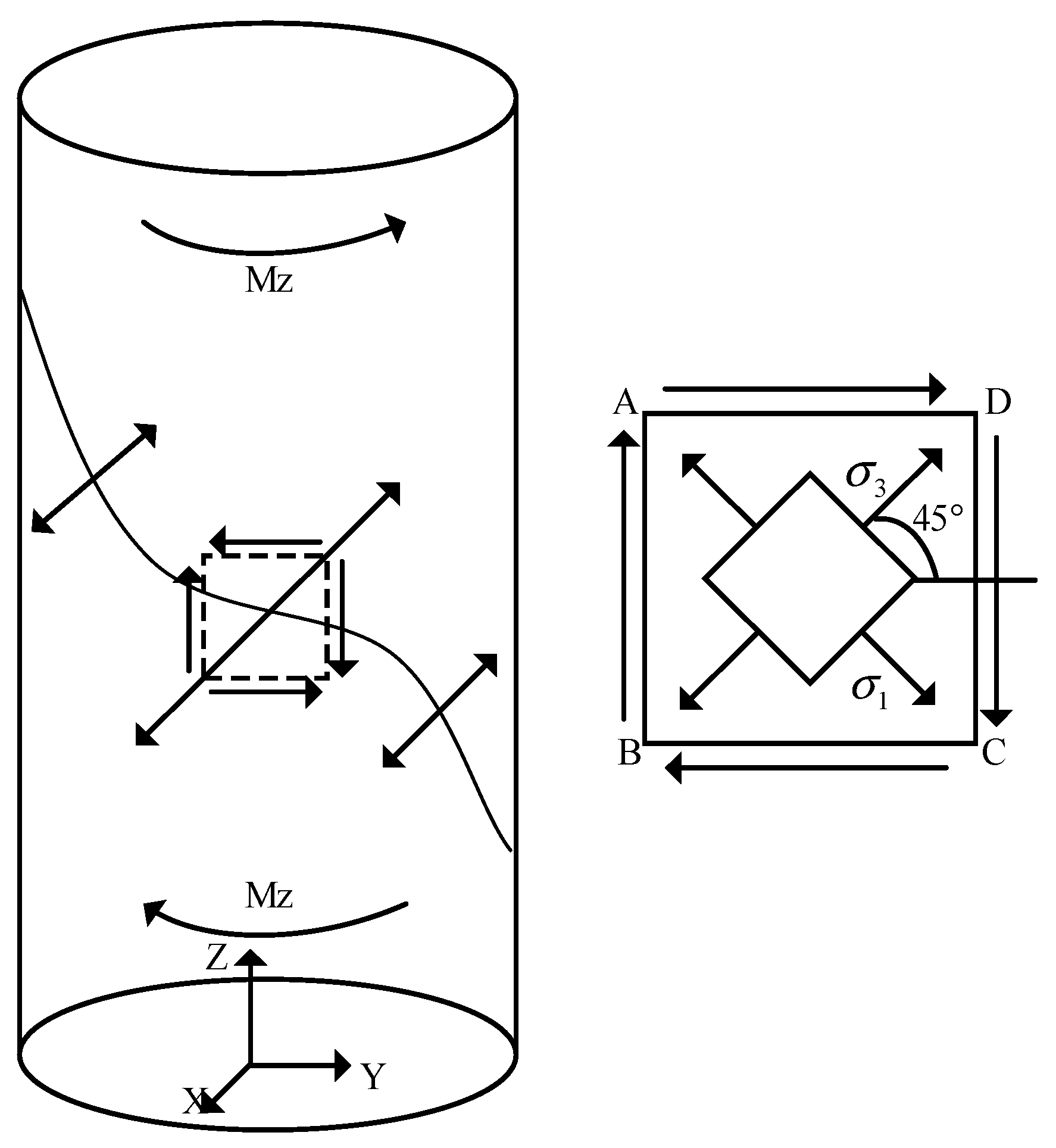

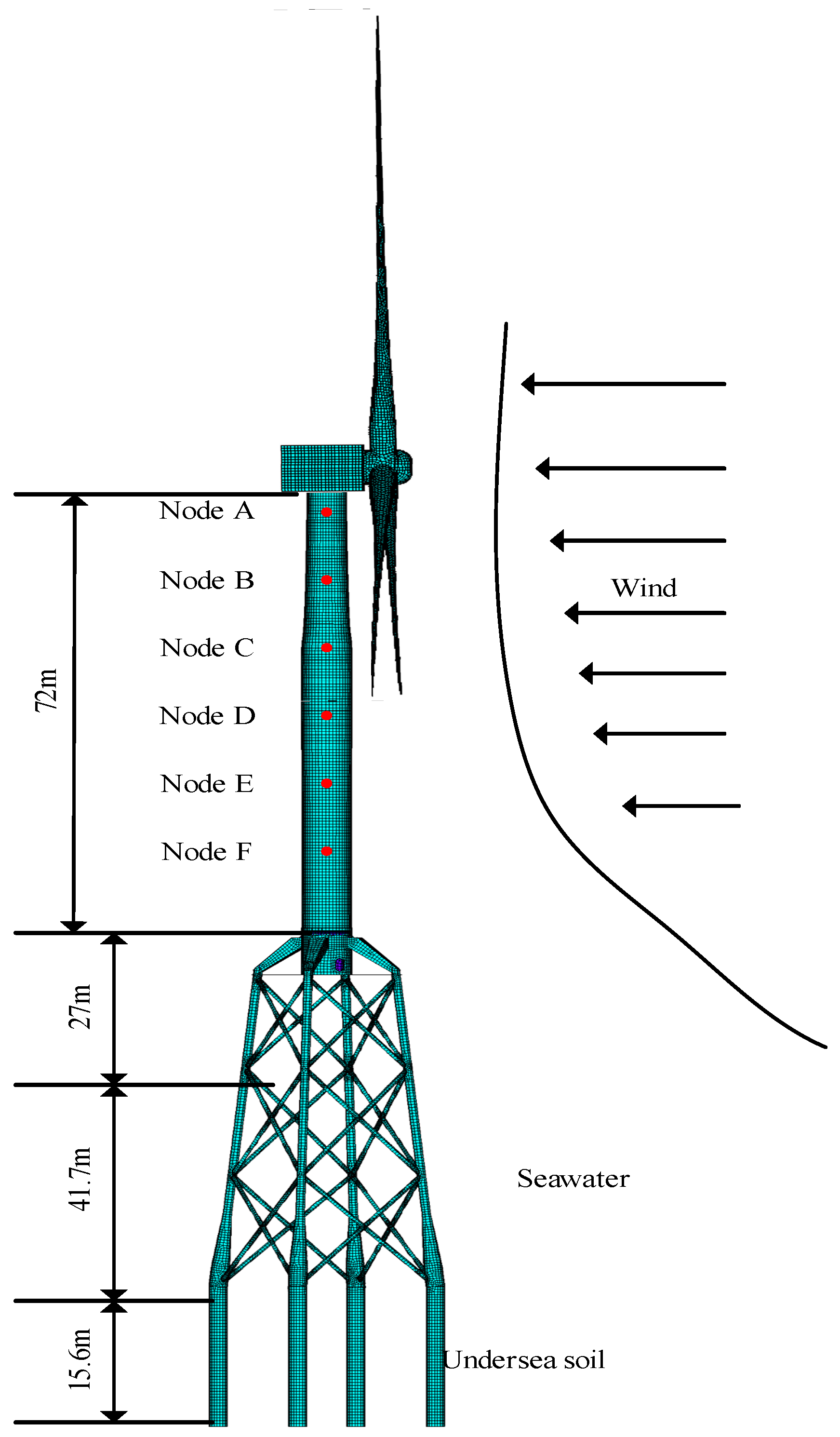
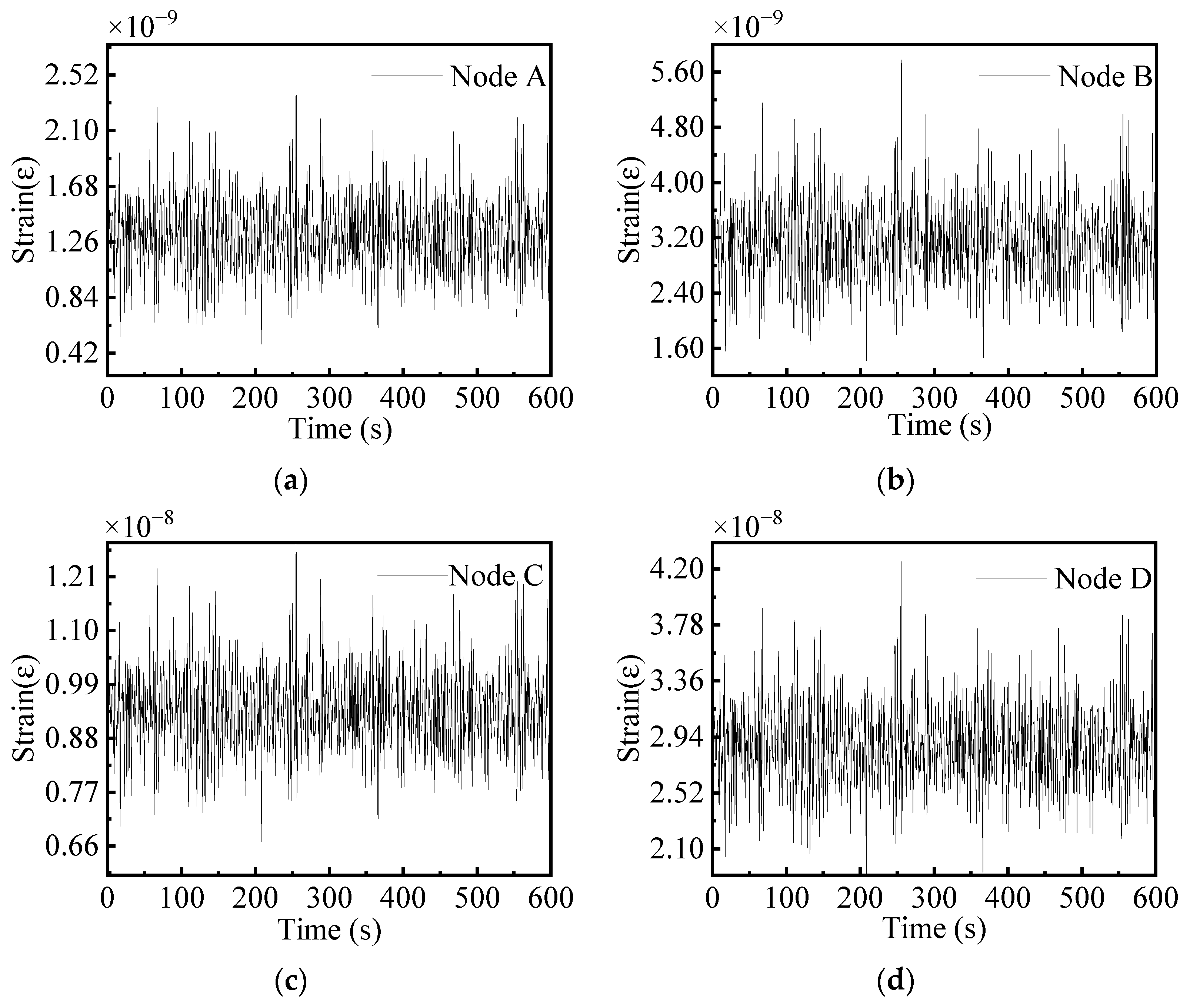


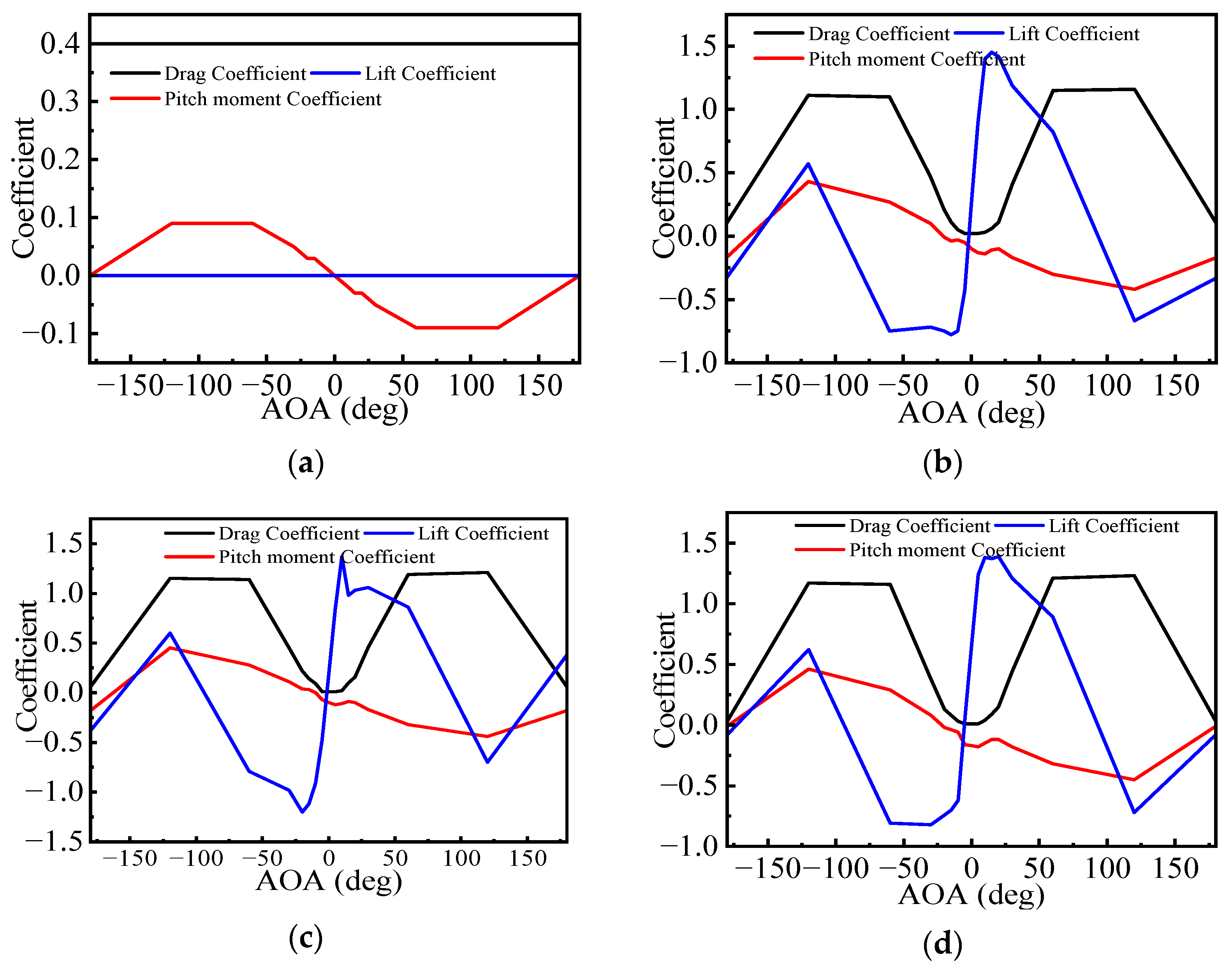

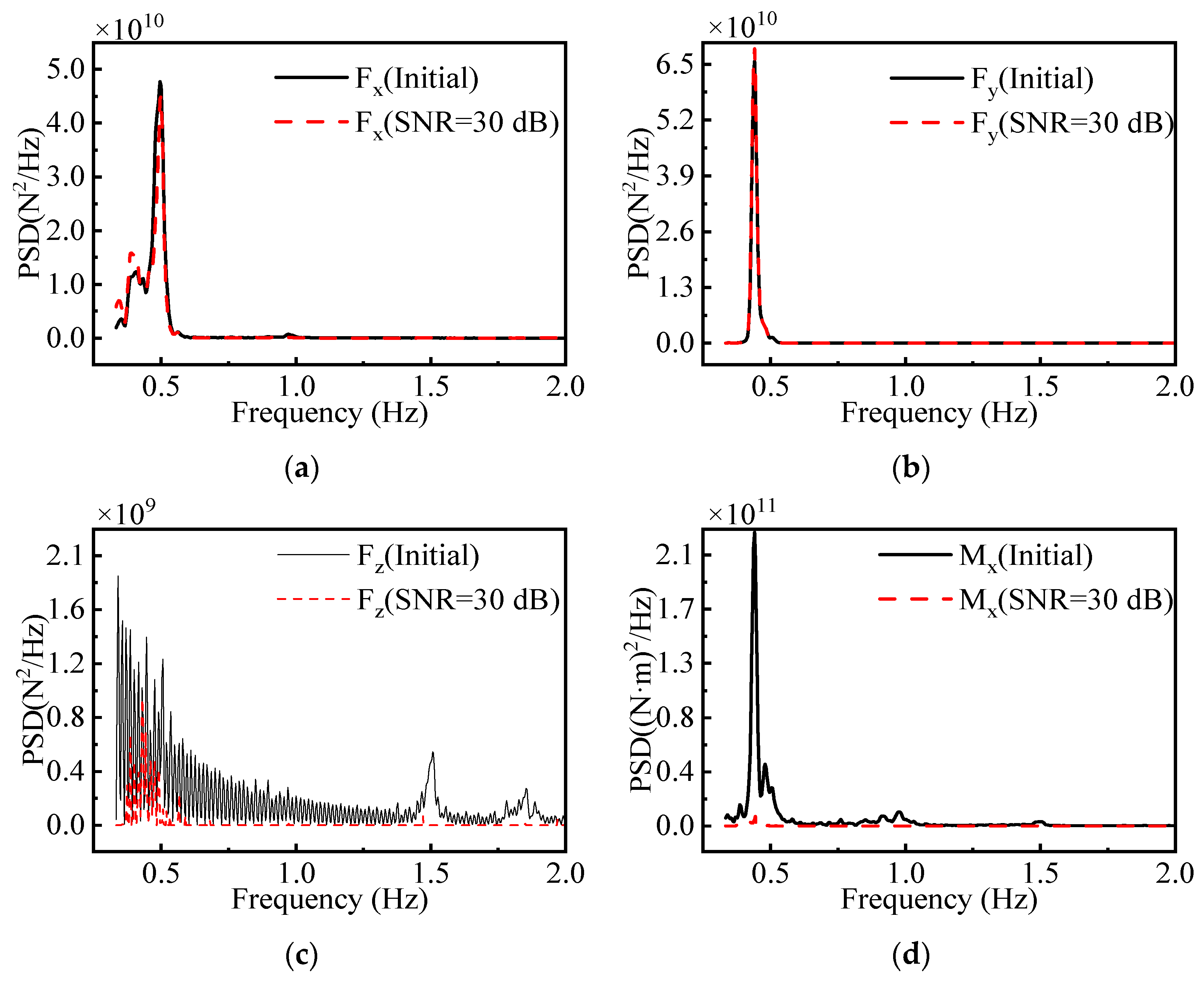
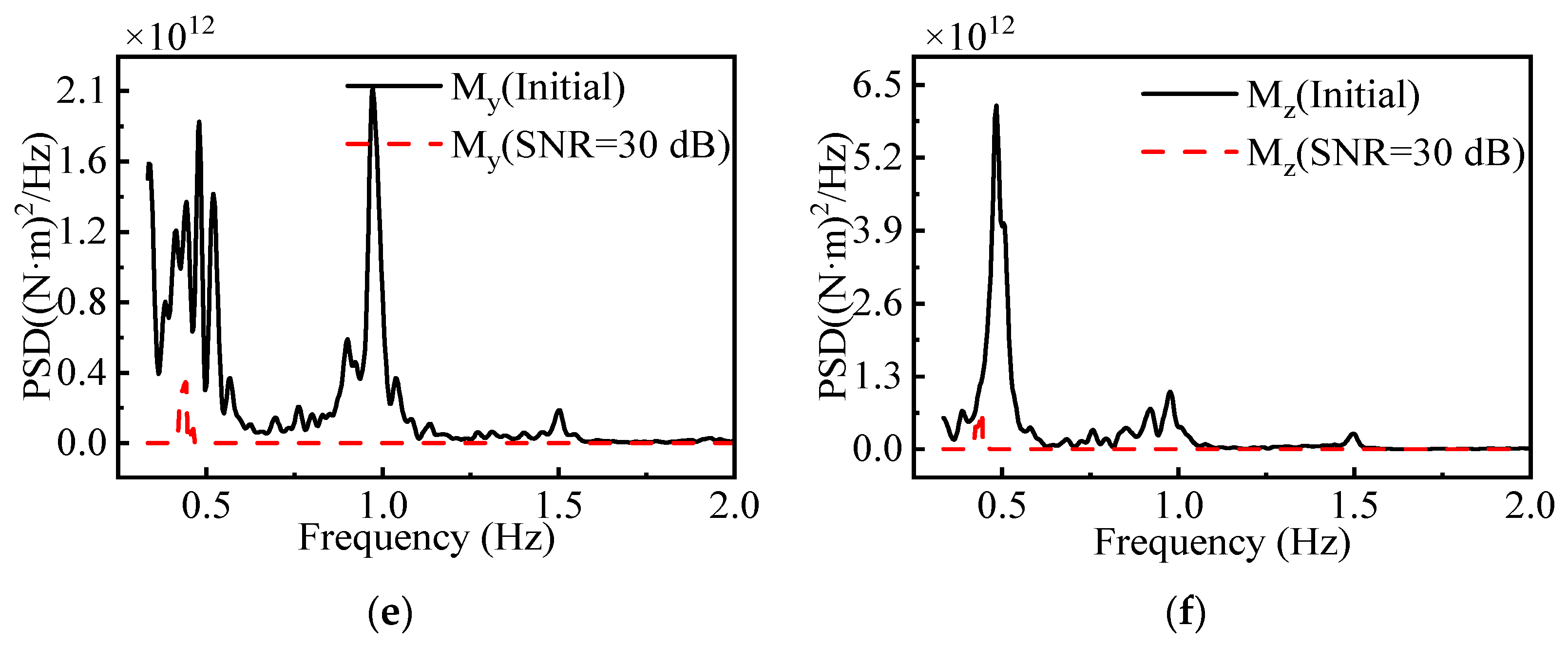
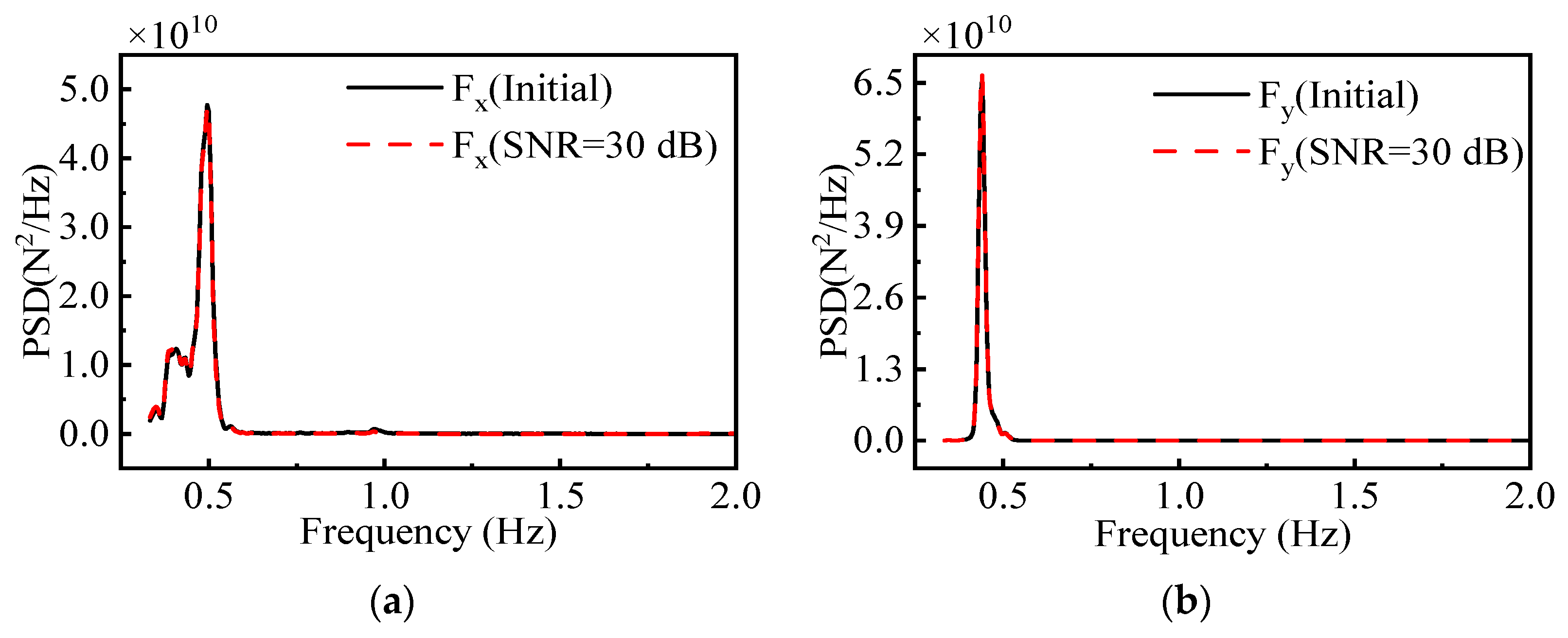
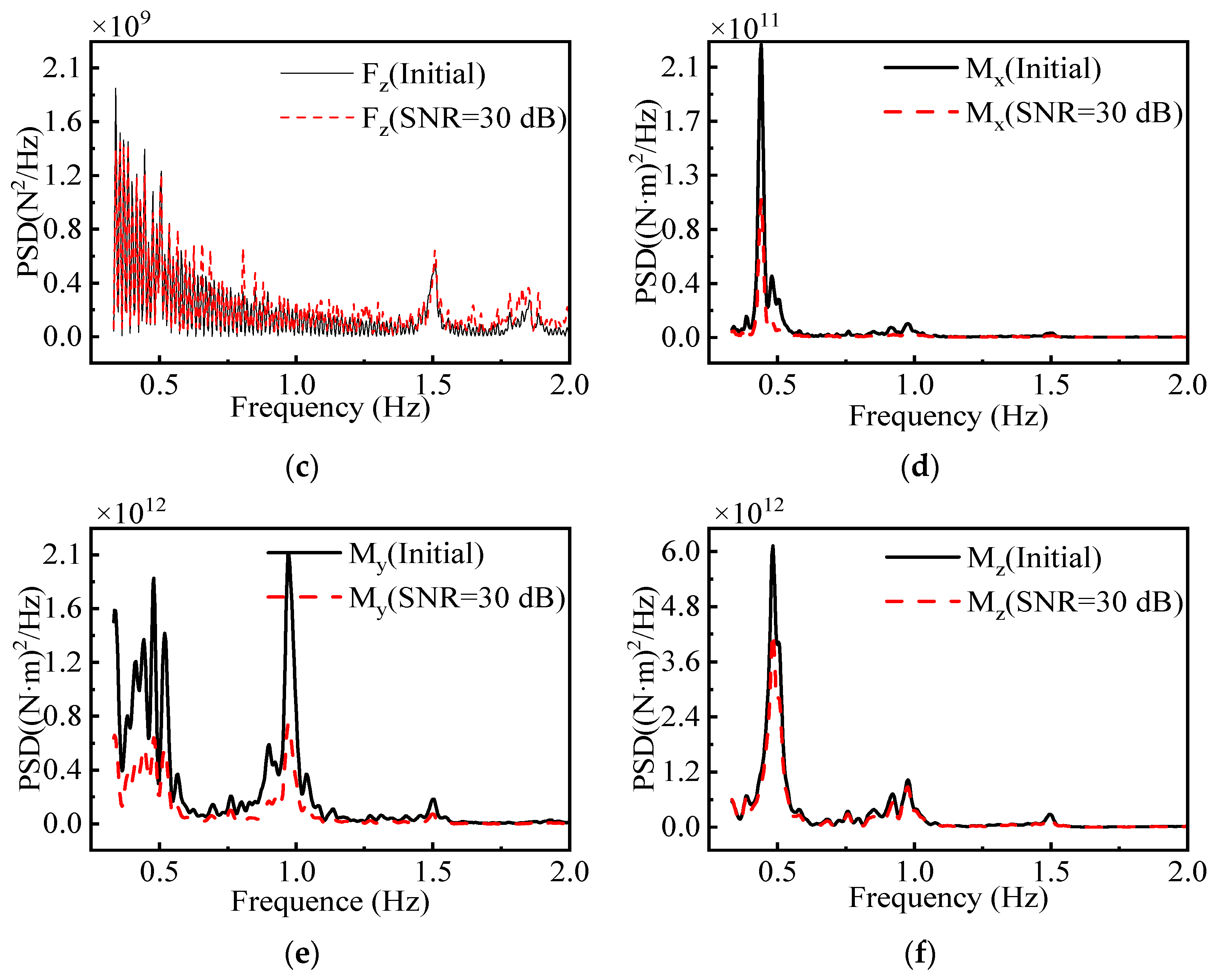
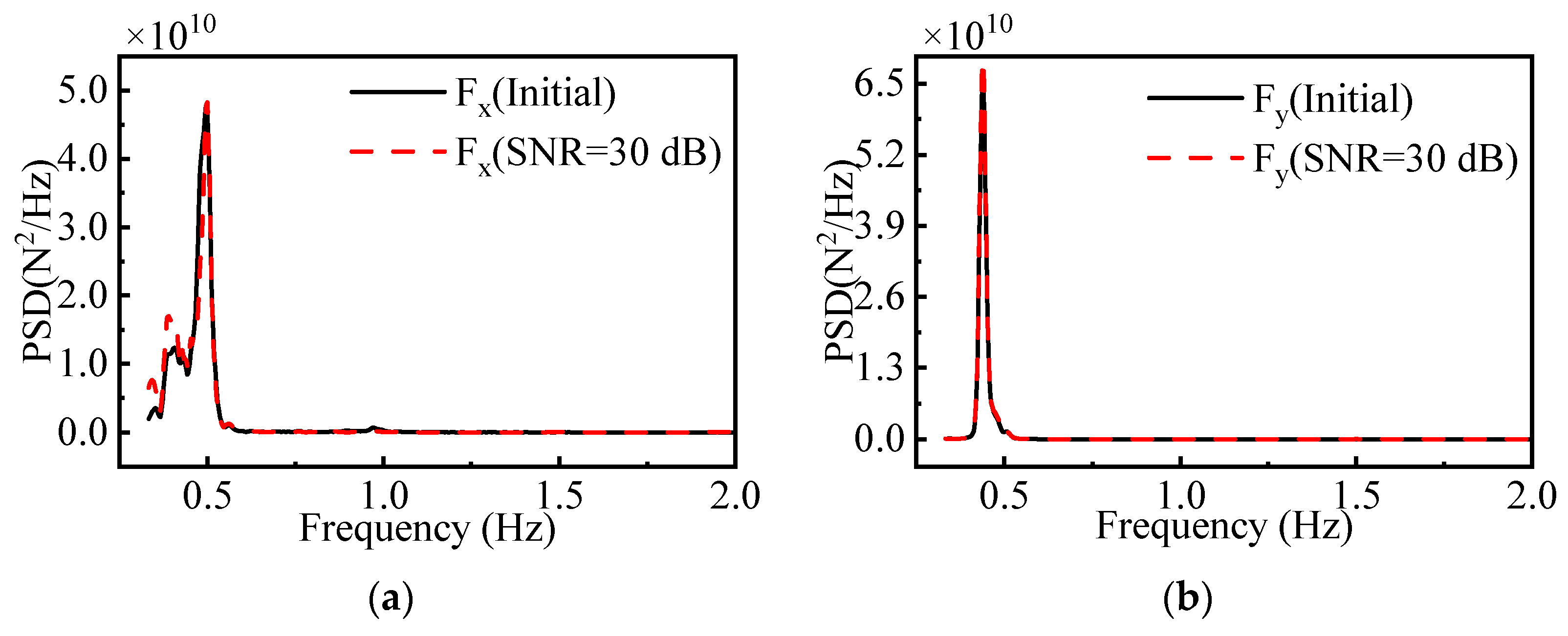

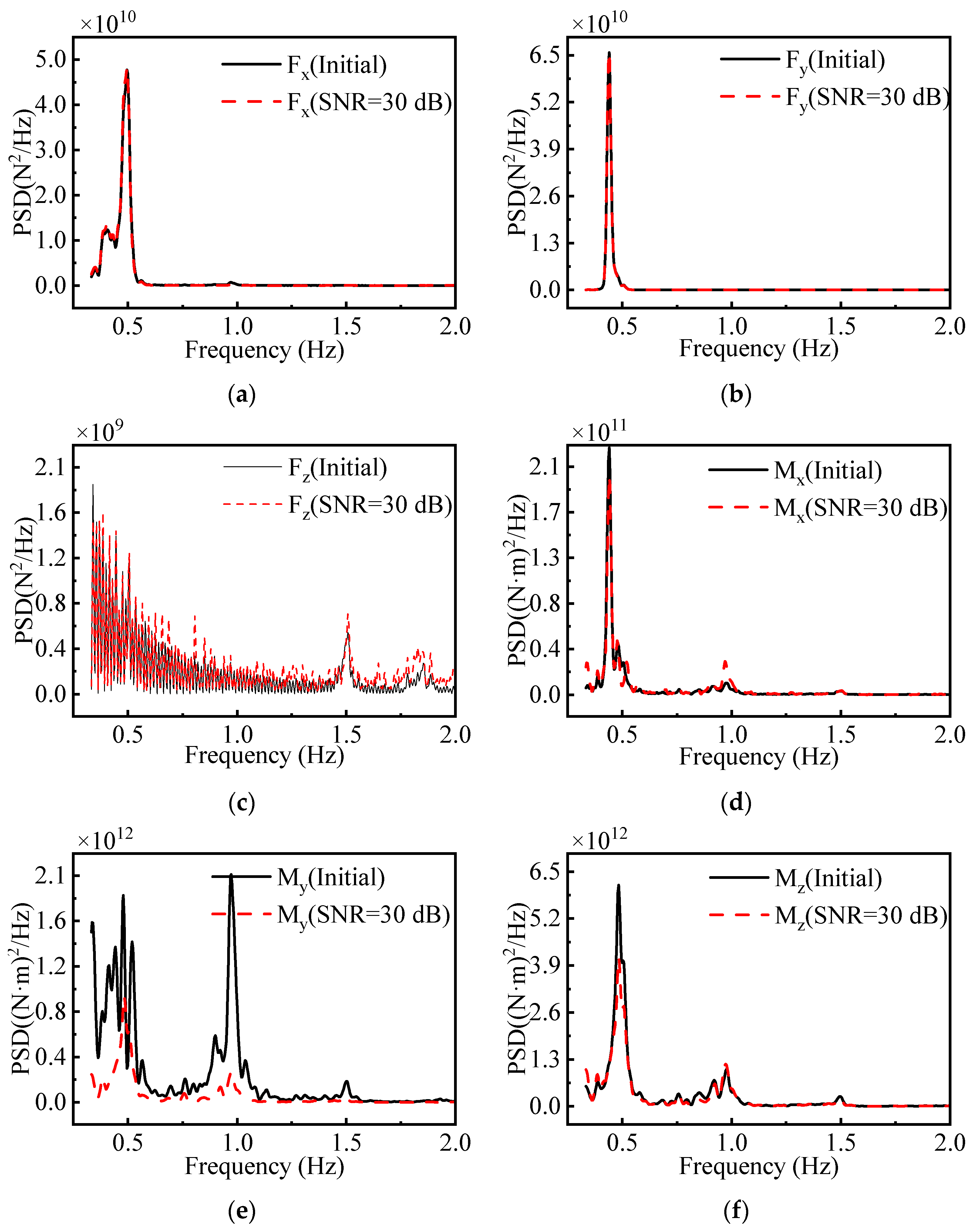
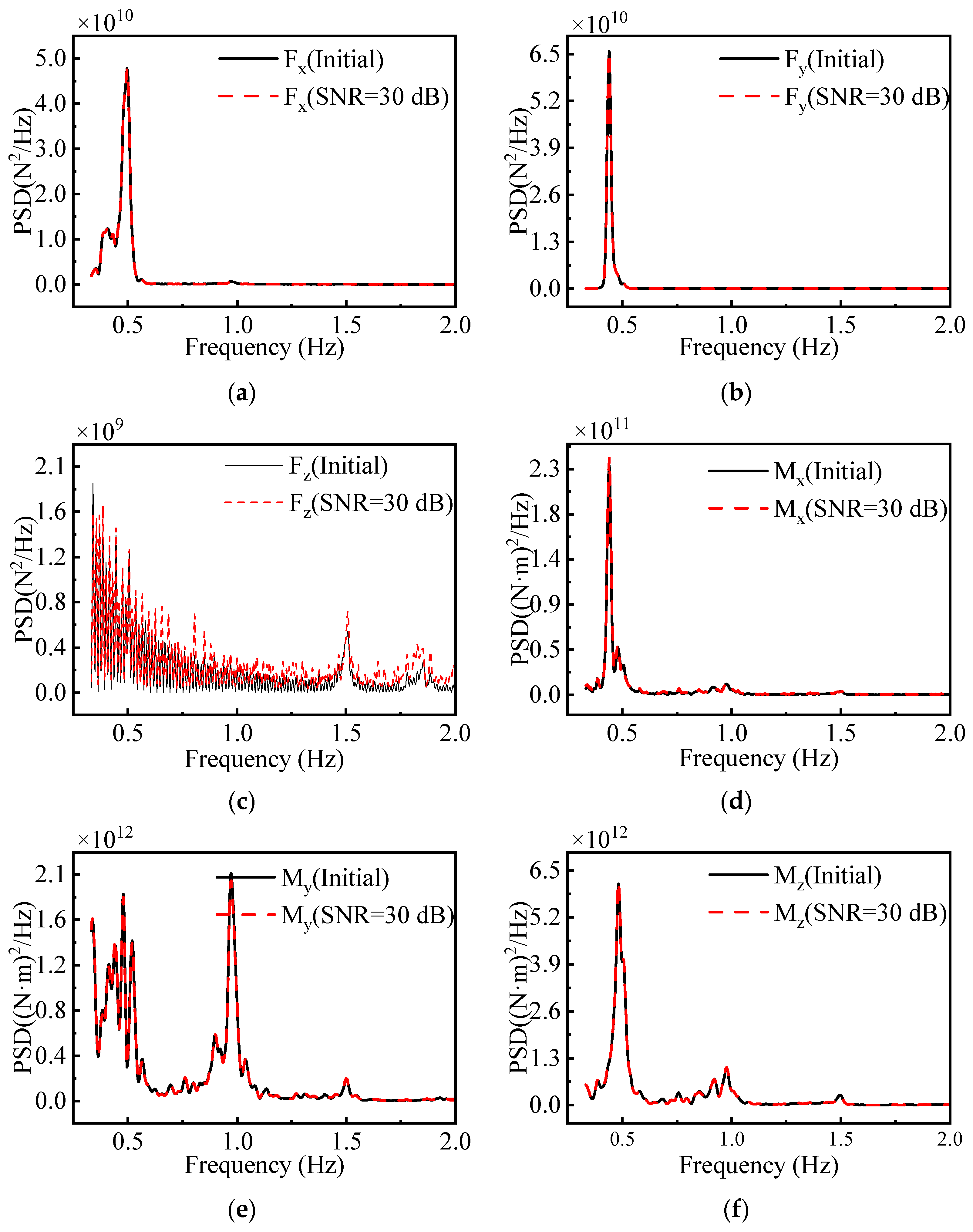
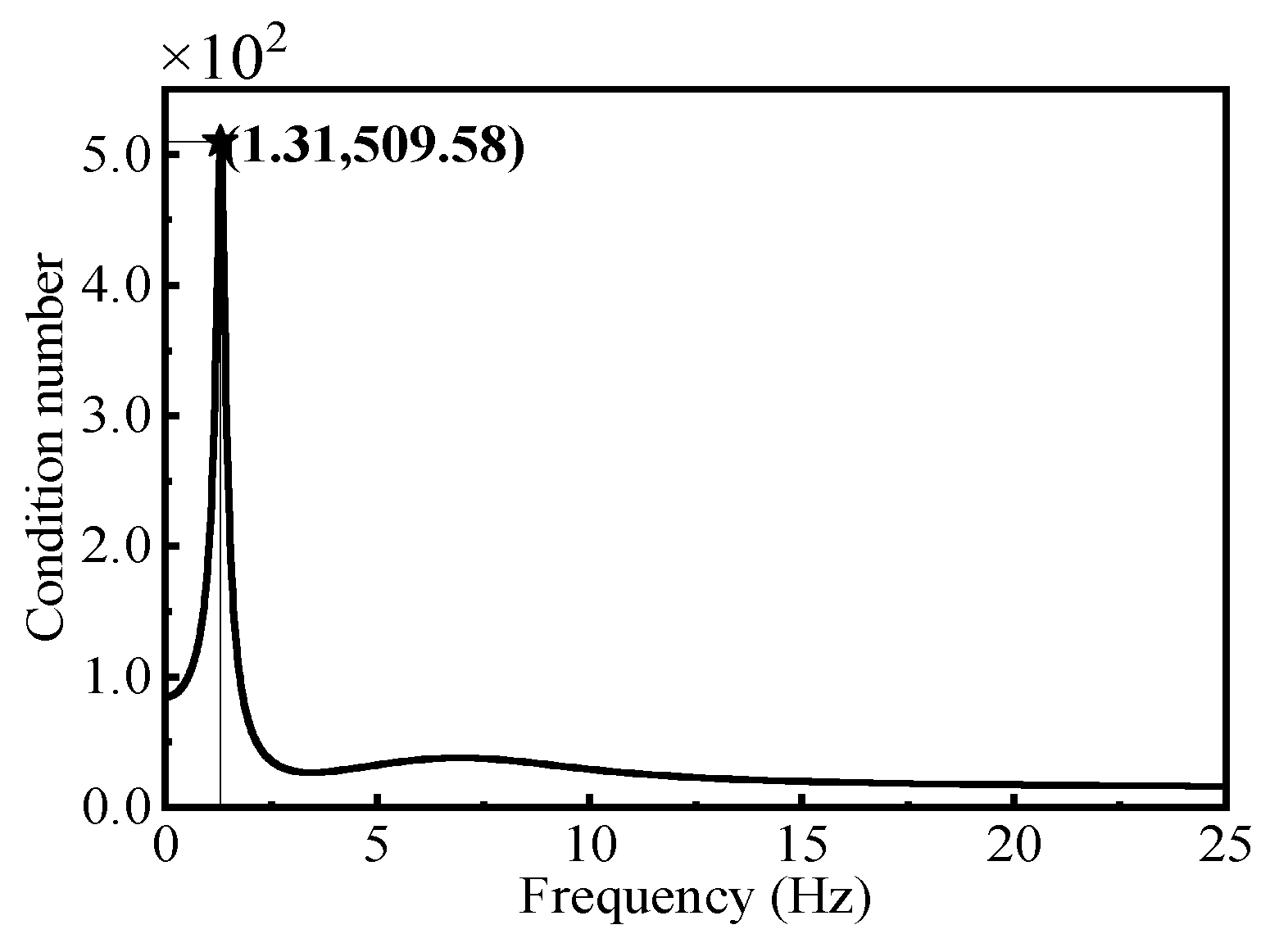
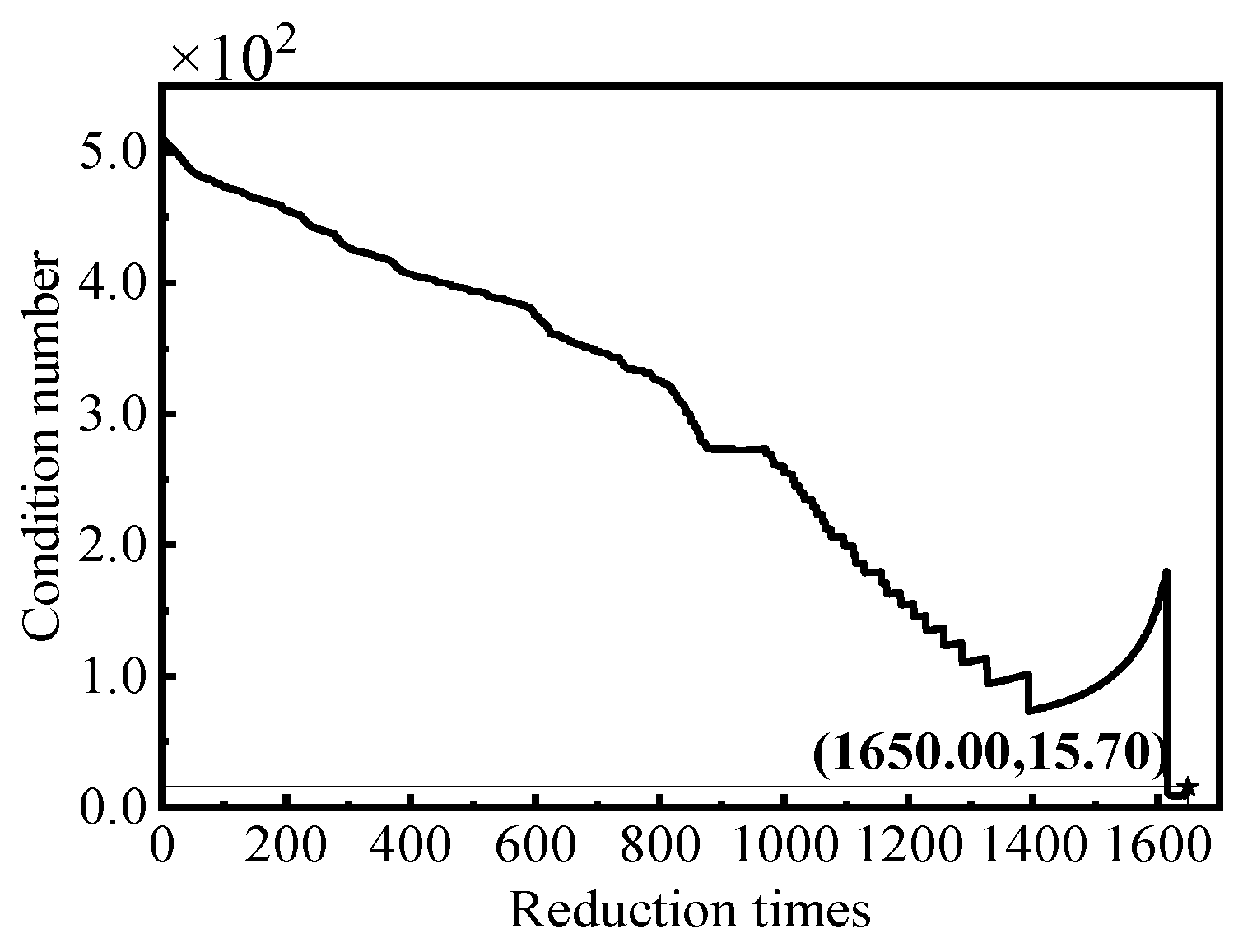
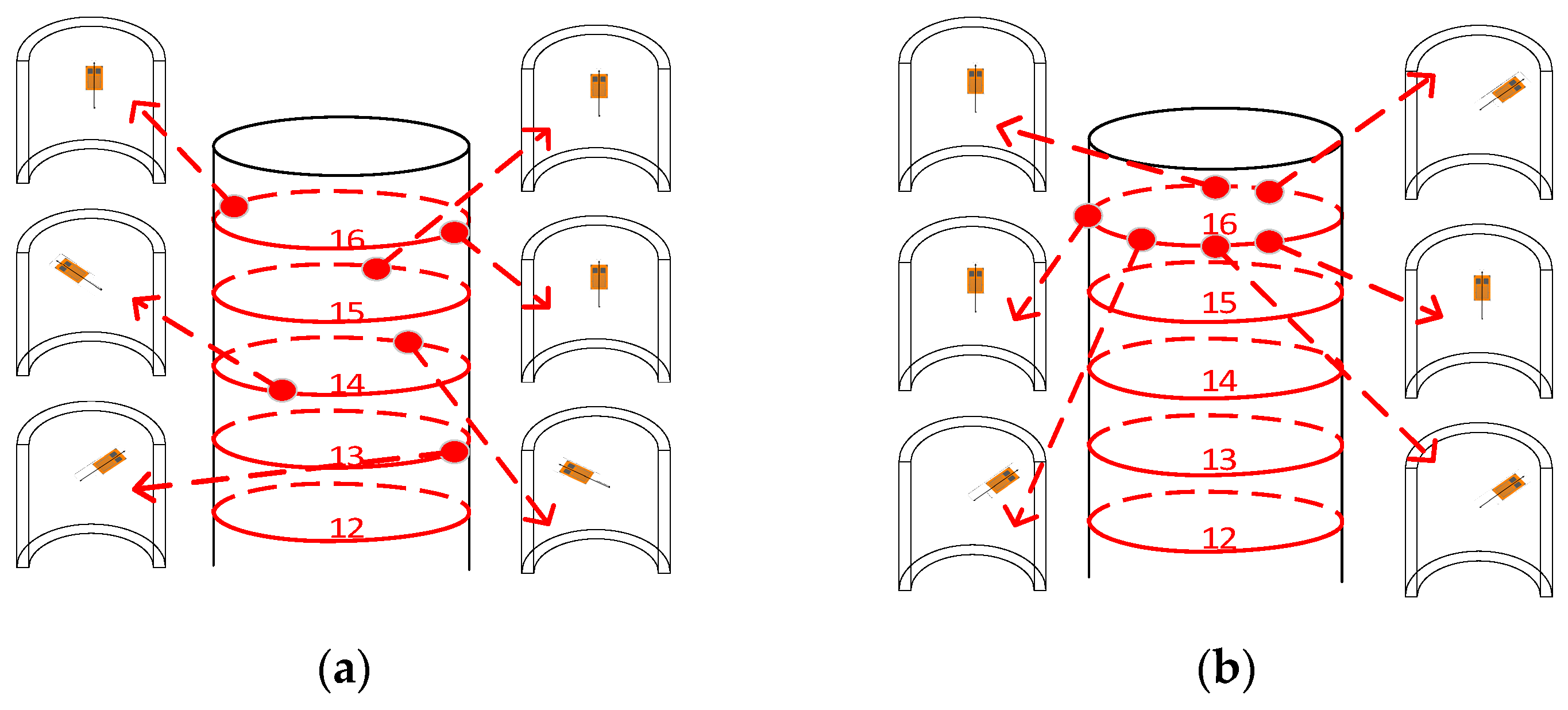
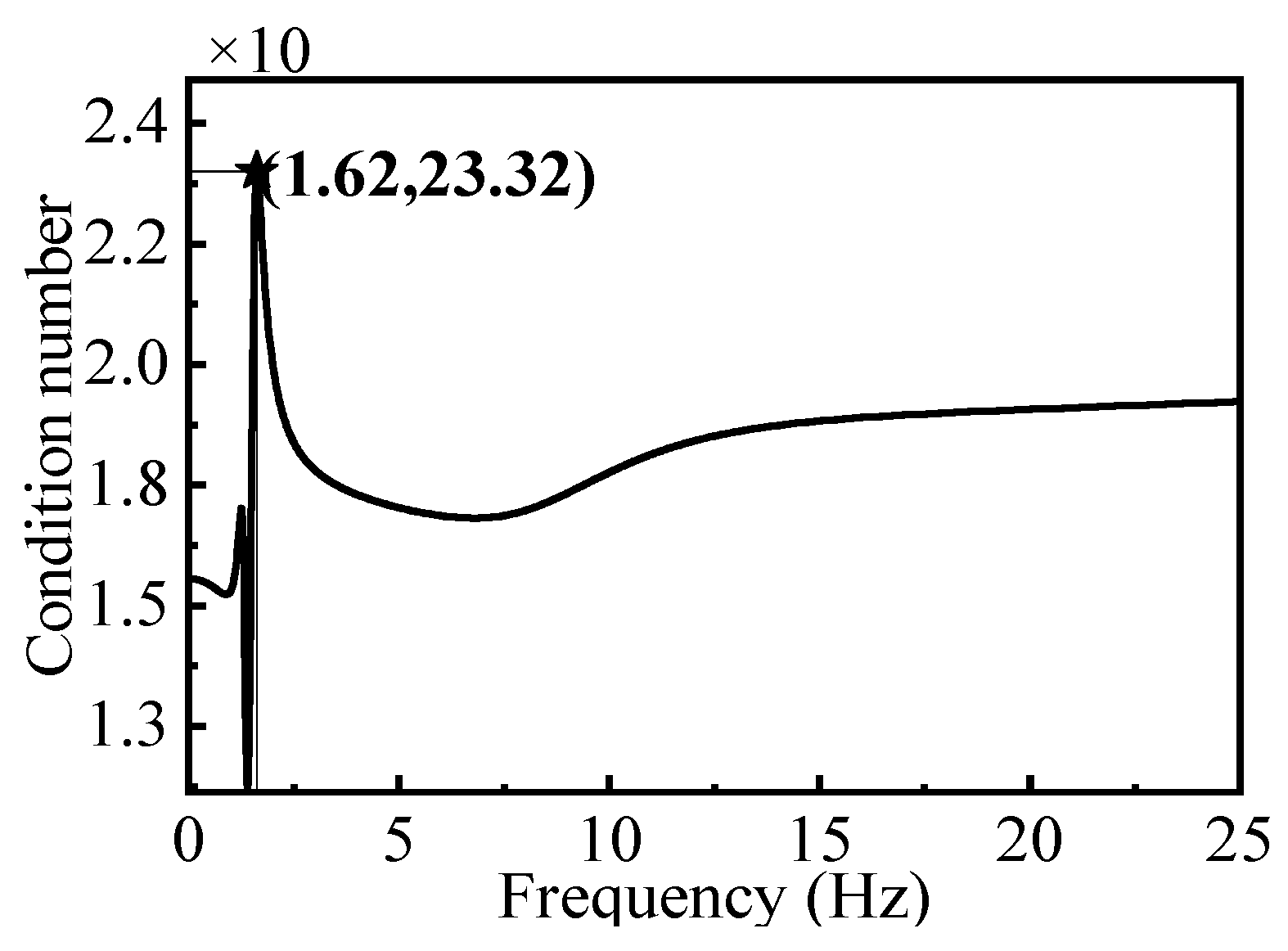
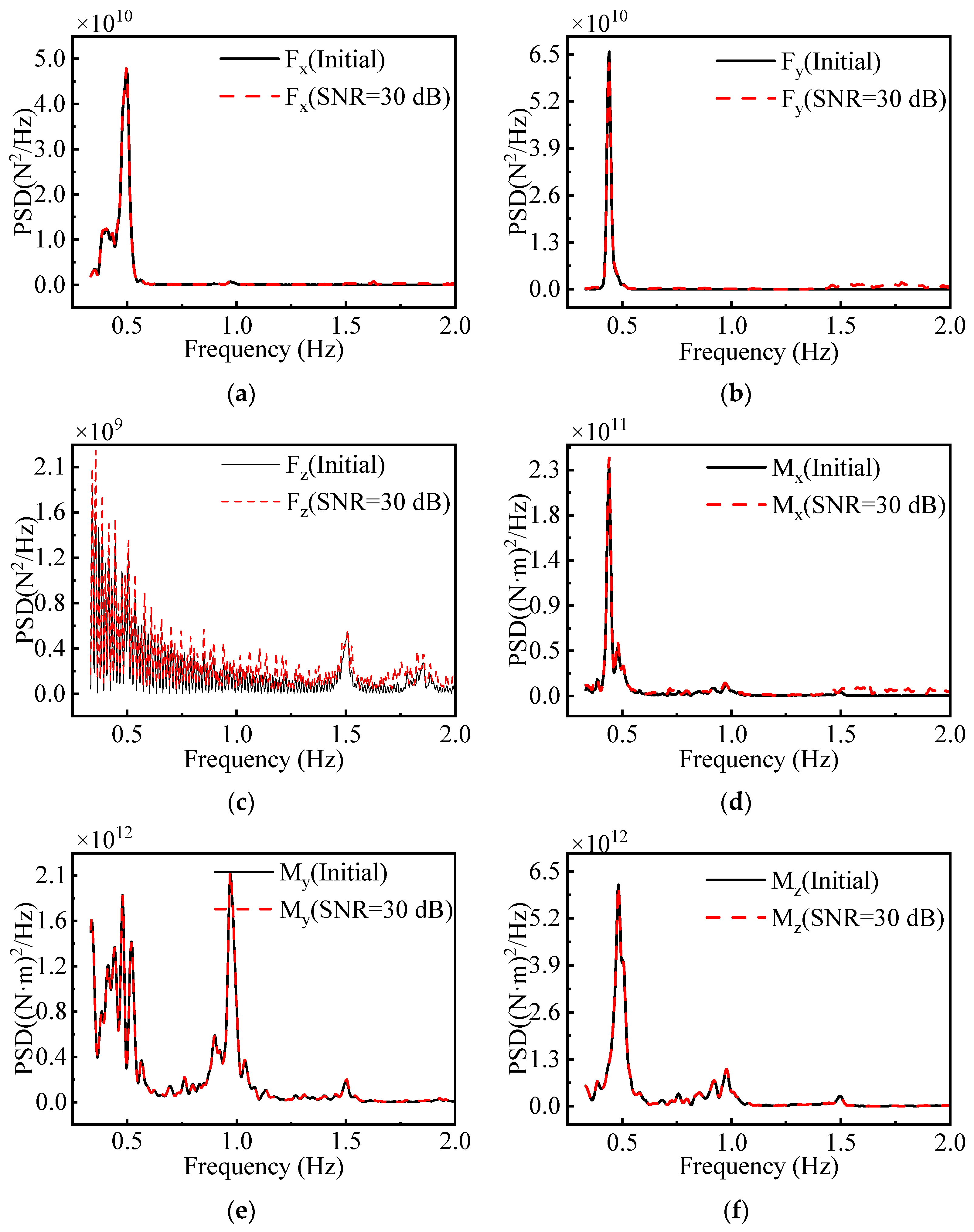
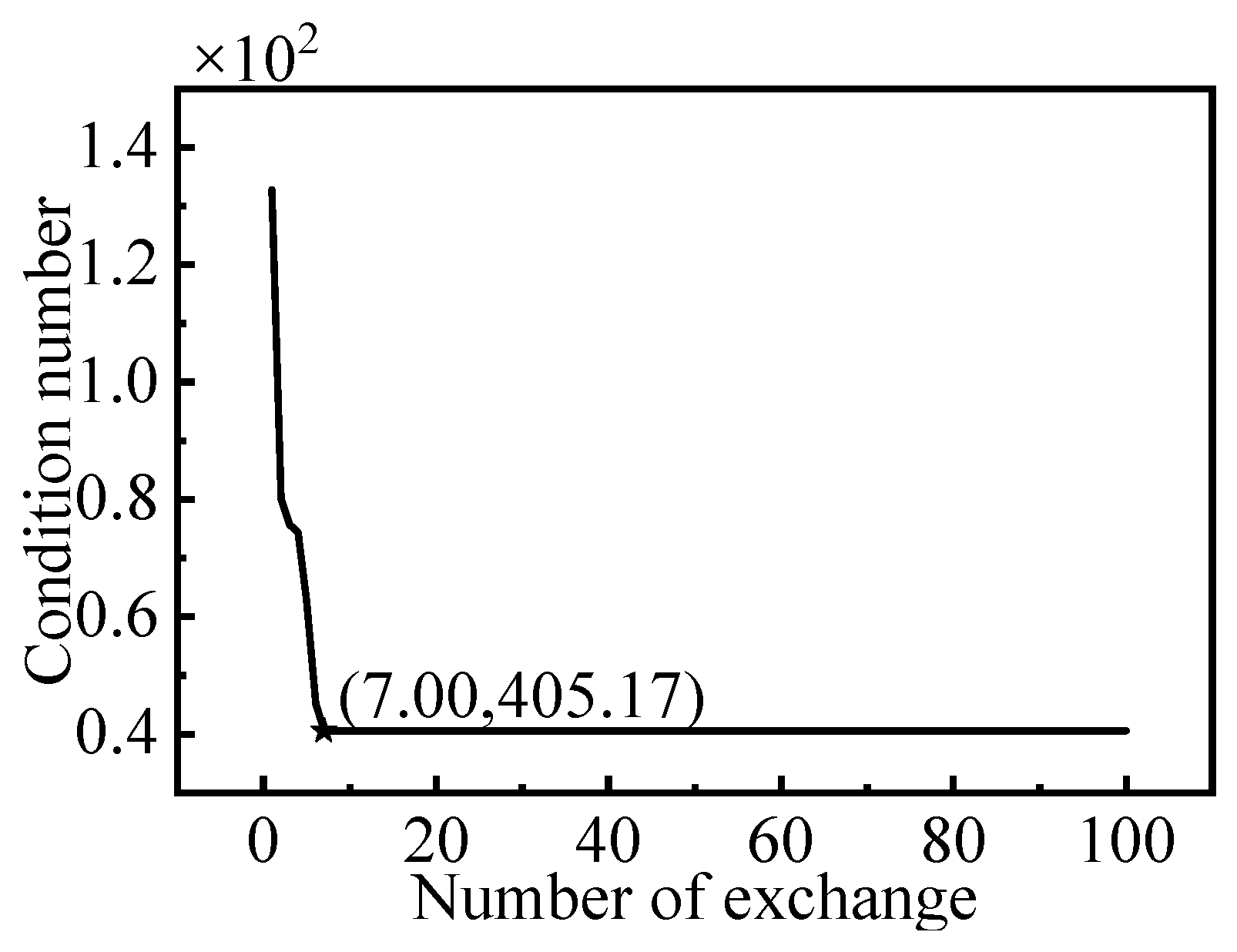
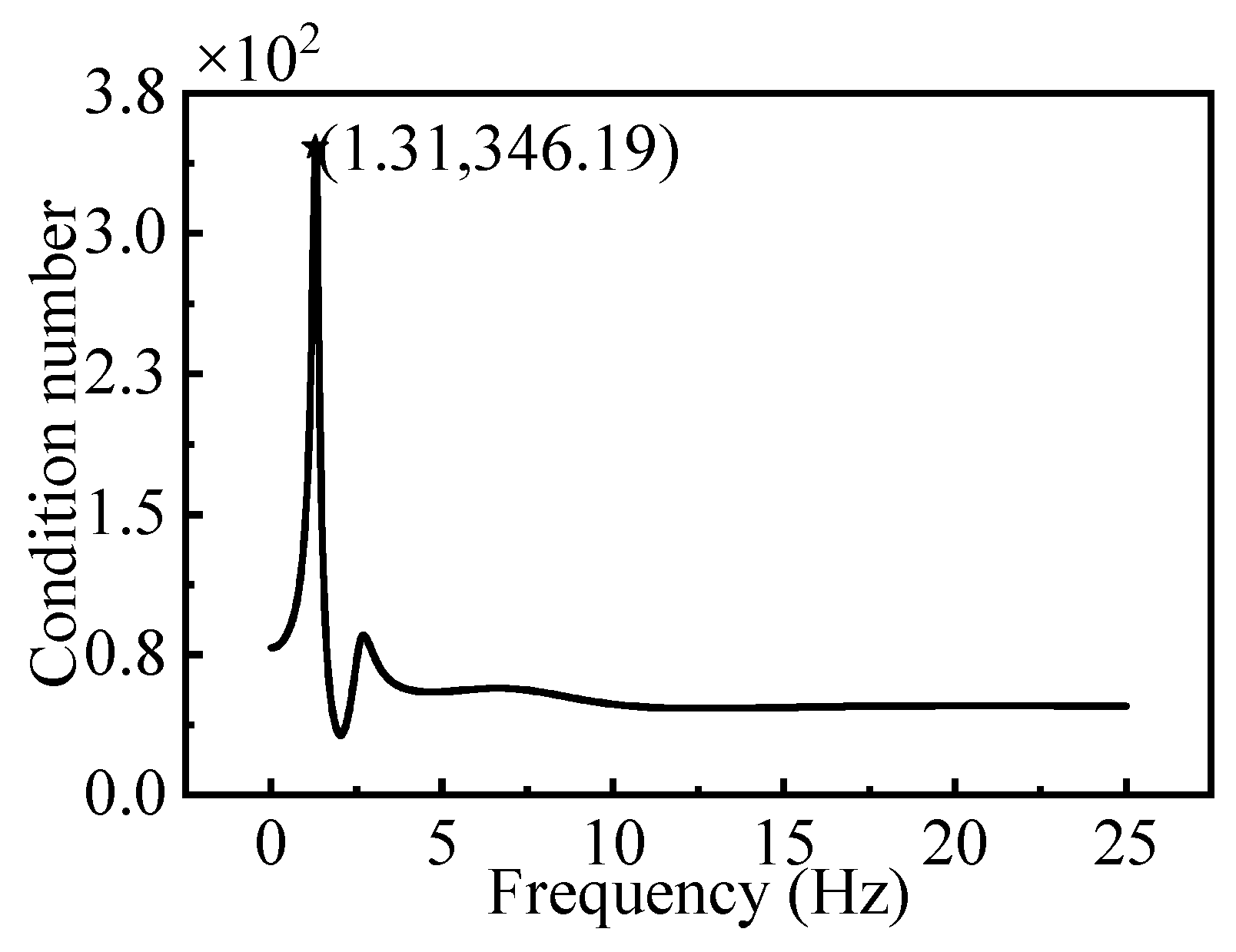

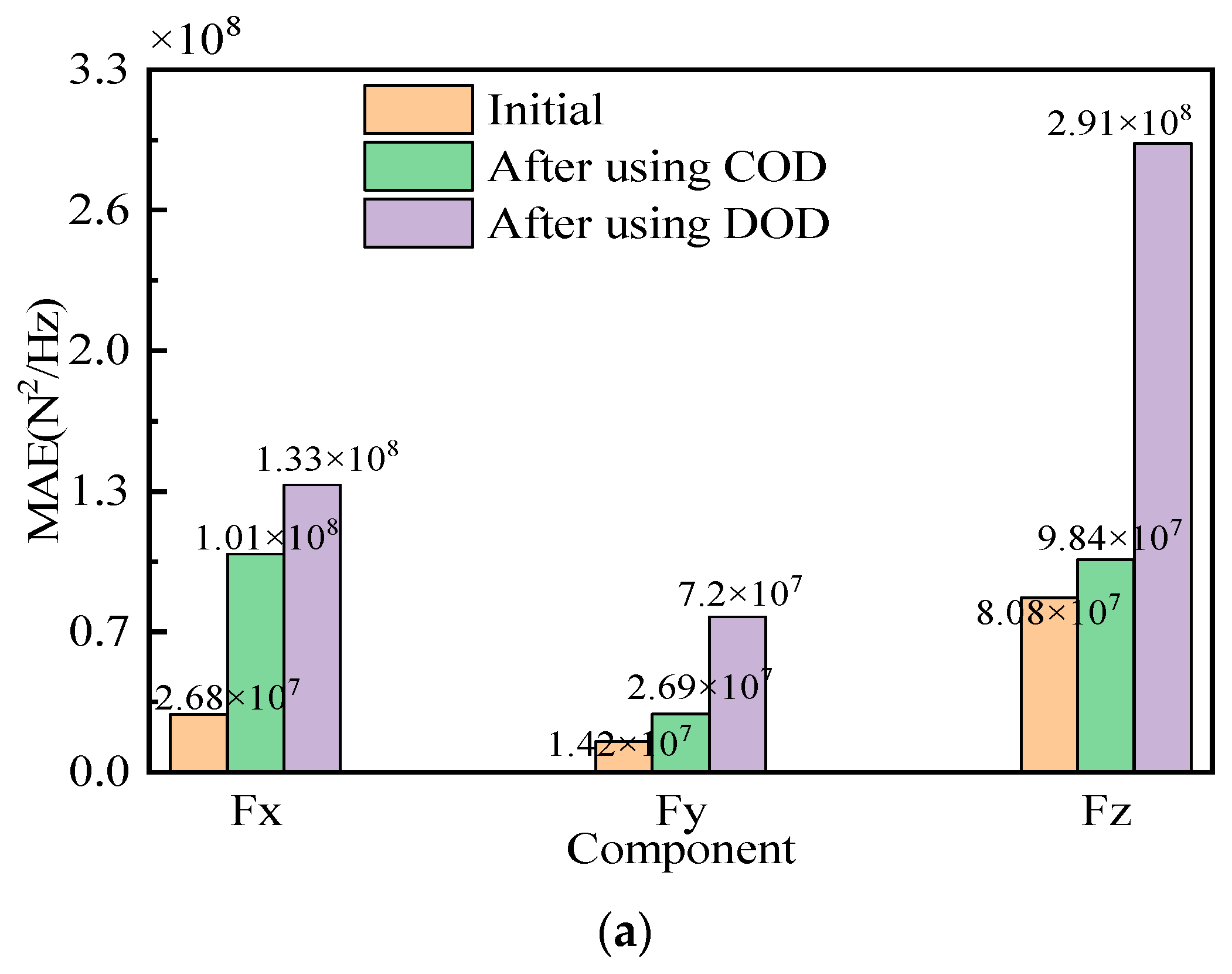
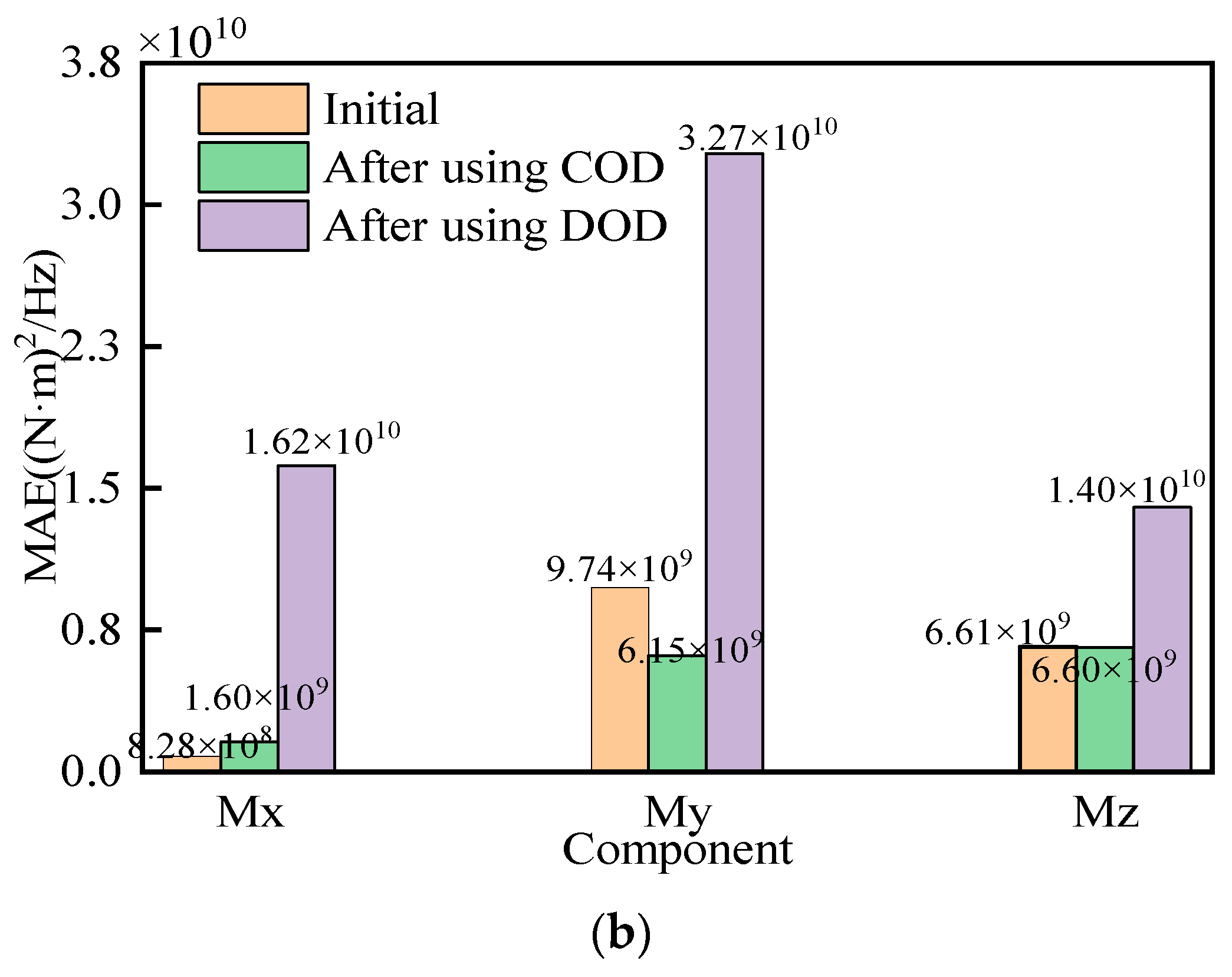

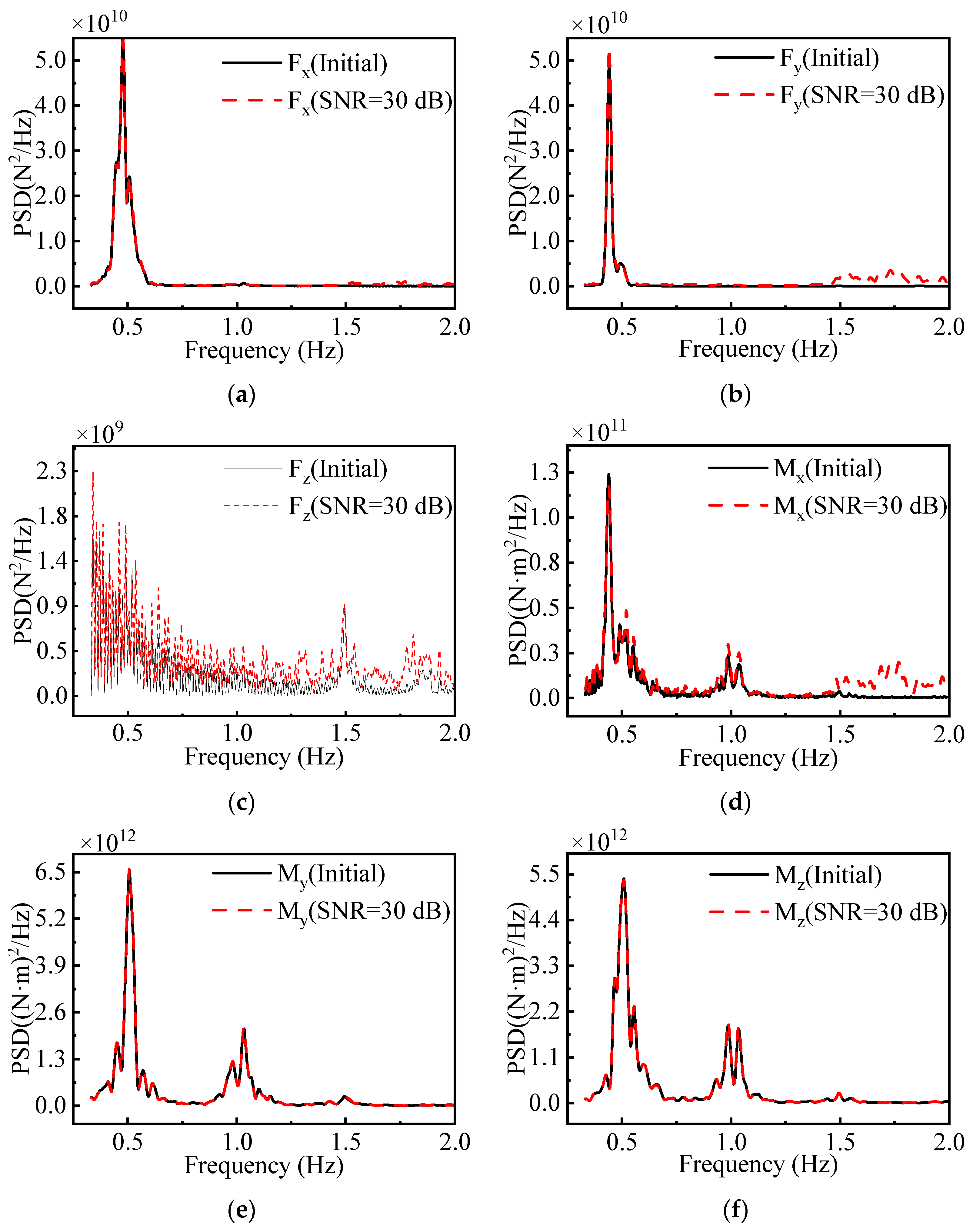
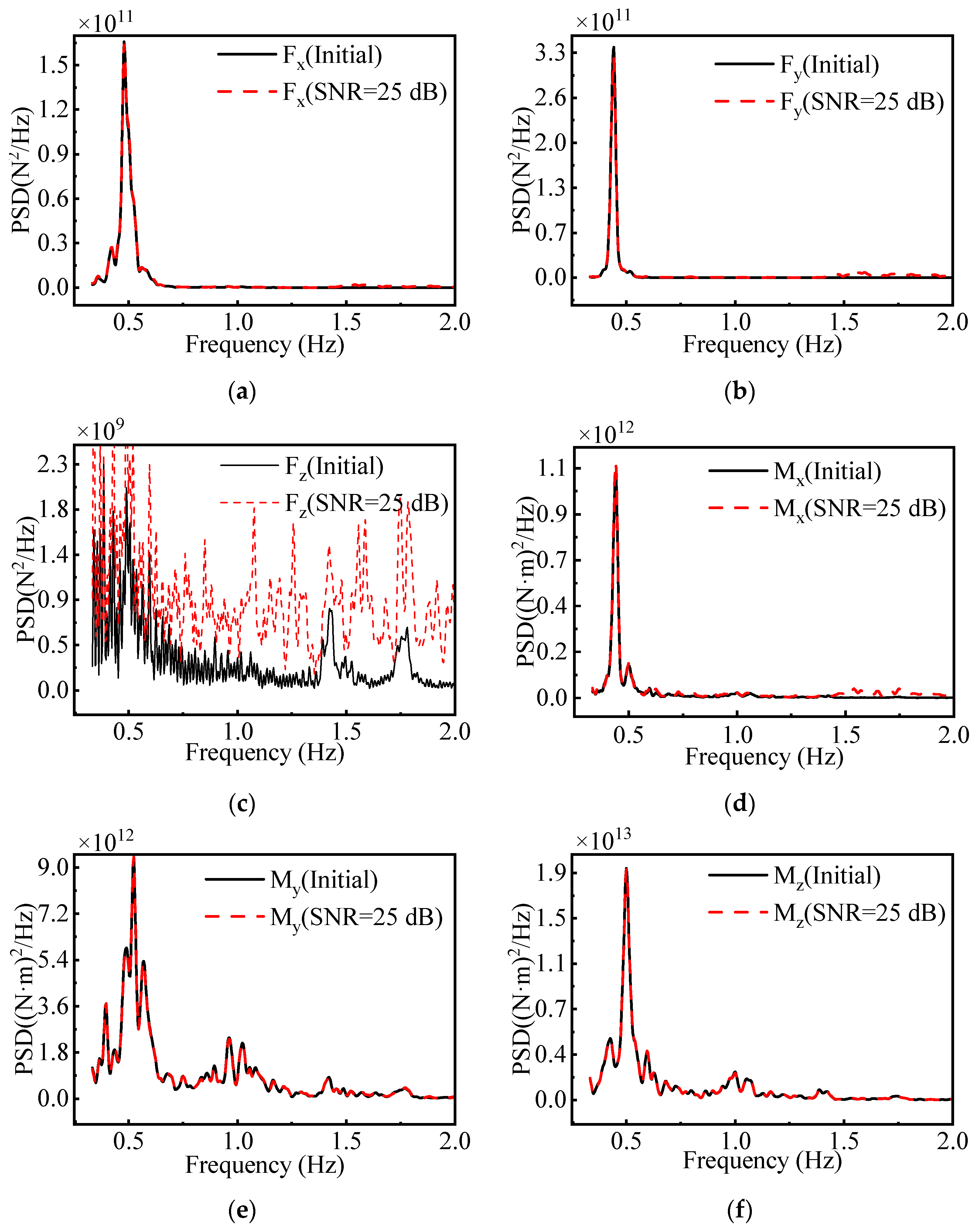
| Node Number | SNR (dB) | SNR (dB) | SNR (dB) |
|---|---|---|---|
| Node 1 | 39.0920 | 38.8284 | 39.9995 |
| Node 2 | 52.2057 | 37.0709 | 32.1821 |
| Node 3 | 52.7516 | 37.7086 | 33.5127 |
| Node 4 | 50.9226 | 36.7145 | 32.8440 |
| Node 5 | 50.8579 | 38.9891 | 35.6809 |
| Node 6 | 50.7789 | 40.1269 | 37.3964 |
| Node 7 | 52.4072 | 41.6726 | 50.6944 |
| Node 8 | 52.7076 | 33.0891 | 44.4267 |
| Node 9 | 49.7327 | 27.8918 | 40.9444 |
| Node 10 | 47.3923 | 27.9521 | 40.2653 |
| Node 11 | 44.9178 | 26.0324 | 40.7441 |
| Node 12 | 43.7101 | 24.7581 | 40.8920 |
| Node 13 | 47.6613 | 38.2679 | 43.3208 |
| Node 14 | 55.9286 | 36.2682 | 40.8216 |
| Node 15 | 56.9565 | 39.3064 | 42.9643 |
| Node 16 | 56.9636 | 39.5892 | 41.6206 |
| Node 17 | 56.3502 | 42.3164 | 44.4427 |
| Node 18 | 55.9141 | 43.9866 | 46.2169 |
| Node 19 | 43.6565 | 39.7544 | 43.4904 |
| Node 20 | 37.4465 | 34.2639 | 36.1277 |
| Node 21 | 29.7839 | 32.0071 | 31.5327 |
| Node 22 | 33.4227 | 34.3829 | 31.2402 |
| Node 23 | 33.9734 | 35.4146 | 30.3160 |
| Node 24 | 33.9923 | 36.1781 | 29.2770 |
| Distance from Root (m) | Chord (m) | Twist (deg) | Thickness (%) | Pitch Axis (%) | Foil Section Number |
|---|---|---|---|---|---|
| 0 | 2.90 | 20 | 99.99 | 50.00 | 1 |
| 10 | 3.82 | 12.28 | 65.85 | 50.85 | 1 |
| 20 | 4.29 | 6.91 | 36.28 | 47.75 | 2 |
| 30 | 3.41 | 3.57 | 32.76 | 43.21 | 2 |
| 40 | 2.63 | 1.20 | 31.19 | 39.87 | 2 |
| 50 | 2.06 | −0.49 | 29.67 | 37.28 | 3 |
| 60 | 1.61 | −1.43 | 26.83 | 36.99 | 3 |
| 70 | 1.17 | −0.28 | 22.27 | 37.76 | 4 |
| 78.9 | 0.05 | 2.54 | 21.00 | 49.20 | 4 |
| Distance from Root (m) | Centre of Mass (x’) (%) | Centre of Mass (y’) (%) | Mass Axis Orientation (deg) | Radius of Gyration Ratio |
|---|---|---|---|---|
| 0 | 0.00 | 50.01 | 0.00 | 1.00 |
| 10 | −0.09 | 49.74 | 19.35 | 0.83 |
| 20 | −0.28 | 47.65 | 10.28 | 0.56 |
| 30 | −0.75 | 44.75 | 7.44 | 0.54 |
| 40 | −0.79 | 42.26 | 4.59 | 0.50 |
| 50 | −0.88 | 40.20 | 2.34 | 0.49 |
| 60 | 0.09 | 40.12 | 0.61 | 0.45 |
| 70 | 2.86 | 40.08 | 1.29 | 0.38 |
| 78.9 | 2.53 | 49.53 | 3.04 | 0.20 |
| Parameter | Value |
|---|---|
| Latitude (deg) | 34 |
| Surface roughness | 0.01 |
| Average wind speed (m/s) | 8 |
| Angular velocity of earth’s rotation (rad/s) | |
| Height of hub centre of wind turbine (m) | 103 |
| Component | TRM + L-Curve | TRM + GCV | TSVD+ L-Curve | TSVD + GCV | Moore–Penrose |
|---|---|---|---|---|---|
| () | 6.60 × 108 | 1.23 × 108 | 6.24 × 108 | 2.12 × 108 | 2.68 × 107 |
| () | 4.91 × 107 | 2.65 × 107 | 8.58 × 107 | 2.24 × 107 | 1.42 × 107 |
| () | 2.09 × 108 | 6.33 × 107 | 9.02 × 107 | 6.46 × 107 | 8.08 × 107 |
| () | 8.44 × 109 | 5.01 × 109 | 6.27 × 109 | 2.89 × 109 | 8.28 × 108 |
| ()) | 3.44 × 1011 | 2.16 × 1011 | 2.88 × 1011 | 2.68 × 1011 | 9.74 × 109 |
| ()) | 4.46 × 1011 | 1.17 × 1011 | 2.16 × 1011 | 1.14 × 1011 | 6.61 × 109 |
| Component | MAE (COD) | MAE (DOD) | MAE (Initial) |
|---|---|---|---|
| () | 1.01 × 108 | 1.33 × 108 | 2.68 × 107 |
| () | 2.69 × 107 | 7.20 × 107 | 1.42 × 107 |
| () | 9.84 × 107 | 2.91 × 108 | 8.08 × 107 |
| () | 1.60 × 109 | 1.62 × 1010 | 8.28 × 108 |
| ()) | 6.15 × 109 | 3.27 × 1010 | 9.74 × 109 |
| ()) | 6.60 × 109 | 1.40 × 1010 | 6.61 × 109 |
| Node Number | Fatigue Damage Values Calculated by Simulation | Fatigue Damage Values Calculated from Identified Load Spectra | Percentage of Relative Error |
|---|---|---|---|
| Node A | 6.37 × 10−4 | 6.43 × 10−4 | 0.9% |
| Node B | 7.17 × 10−4 | 7.09 × 10−4 | 1.2% |
| Node C | 1.87 × 10−5 | 1.86 × 10−5 | 0.2% |
| Node D | 8.26 × 10−4 | 8.26 × 10−4 | 0.1% |
| Node E | 8.63 × 10−4 | 8.65 × 10−4 | 0.2% |
| Node F | 1.00 × 10−3 | 9.95 × 10−4 | 0.5% |
| Component | MAE |
|---|---|
| () | 1.34 × 108 |
| () | 2.99 × 108 |
| () | 1.17 × 108 |
| () | 2.27 × 109 |
| ()) | 7.31 × 109 |
| ()) | 8.03 × 109 |
| Node Number | Fatigue Damage Values Calculated by Simulation | Fatigue Damage Values Calculated from Identified Load Spectra | Percentage of Relative Error |
|---|---|---|---|
| Node A | 2.43 × 10−3 | 2.51 × 10−3 | 3.3% |
| Node B | 1.17 × 10−3 | 1.15 × 10−3 | 1.8% |
| Node C | 1.17 × 10−5 | 1.17 × 10−5 | 0.0% |
| Node D | 1.51 × 10−3 | 1.51 × 10−3 | 0.4% |
| Node E | 1.14 × 10−3 | 1.14 × 10−3 | 0.1% |
| Node F | 1.60 × 10−3 | 1.58 × 10−3 | 1.3% |
| Component | MAE |
|---|---|
| () | 1.41 × 108 |
| () | 3.41 × 108 |
| () | 1.56 × 108 |
| () | 2.29 × 109 |
| ()) | 1.17 × 1010 |
| ()) | 1.10 × 1010 |
| Node Number | Fatigue Damage Values Calculated by Simulation | Fatigue Damage Values Calculated from Identified Load Spectra | Percentage of Relative Error |
|---|---|---|---|
| Node A | 3.36 × 10−4 | 3.39 × 10−4 | 0.9% |
| Node B | 1.86 × 10−3 | 1.83 × 10−3 | 1.8% |
| Node C | 2.66 × 10−5 | 2.66 × 10−5 | 0.1% |
| Node D | 2.10 × 10−3 | 2.10 × 10−3 | 0.0% |
| Node E | 7.48 × 10−4 | 7.48 × 10−4 | 0.0% |
| Node F | 1.61 × 10−3 | 1.59 × 10−3 | 1.7% |
| Component | MAE |
|---|---|
| () | 3.40 × 108 |
| () | 1.03 × 109 |
| () | 5.98 × 108 |
| () | 6.64 × 109 |
| ()) | 3.01 × 1010 |
| ()) | 3.45 × 1010 |
| Node Number | Fatigue Damage Values Calculated by Simulation | Fatigue Damage Values Calculated from Identified Load Spectra | Percentage of Relative Error |
|---|---|---|---|
| Node A | 6.23 × 10−5 | 6.59 × 10−5 | 5.7% |
| Node B | 2.14 × 10−4 | 2.26 × 10−4 | 4.2% |
| Node C | 7.31 × 10−5 | 7.68 × 10−5 | 5.1% |
| Node D | 5.68 × 10−4 | 5.74 × 10−4 | 1.1% |
| Node E | 4.13 × 10−3 | 4.29 × 10−3 | 3.9% |
| Node F | 6.35 × 10−5 | 6.68 × 10−5 | 5.2% |
Disclaimer/Publisher’s Note: The statements, opinions and data contained in all publications are solely those of the individual author(s) and contributor(s) and not of MDPI and/or the editor(s). MDPI and/or the editor(s) disclaim responsibility for any injury to people or property resulting from any ideas, methods, instructions or products referred to in the content. |
© 2024 by the authors. Licensee MDPI, Basel, Switzerland. This article is an open access article distributed under the terms and conditions of the Creative Commons Attribution (CC BY) license (https://creativecommons.org/licenses/by/4.0/).
Share and Cite
Zhu, F.; Zhang, M.; Ma, F.; Li, Z.; Qu, X. Identification of Wind Load Exerted on the Jacket Wind Turbines from Optimally Placed Strain Gauges Using C-Optimal Design and Mathematical Model Reduction. J. Mar. Sci. Eng. 2024, 12, 563. https://doi.org/10.3390/jmse12040563
Zhu F, Zhang M, Ma F, Li Z, Qu X. Identification of Wind Load Exerted on the Jacket Wind Turbines from Optimally Placed Strain Gauges Using C-Optimal Design and Mathematical Model Reduction. Journal of Marine Science and Engineering. 2024; 12(4):563. https://doi.org/10.3390/jmse12040563
Chicago/Turabian StyleZhu, Fan, Meng Zhang, Fuxuan Ma, Zhihua Li, and Xianqiang Qu. 2024. "Identification of Wind Load Exerted on the Jacket Wind Turbines from Optimally Placed Strain Gauges Using C-Optimal Design and Mathematical Model Reduction" Journal of Marine Science and Engineering 12, no. 4: 563. https://doi.org/10.3390/jmse12040563
APA StyleZhu, F., Zhang, M., Ma, F., Li, Z., & Qu, X. (2024). Identification of Wind Load Exerted on the Jacket Wind Turbines from Optimally Placed Strain Gauges Using C-Optimal Design and Mathematical Model Reduction. Journal of Marine Science and Engineering, 12(4), 563. https://doi.org/10.3390/jmse12040563






